The CDC describes the current state of nicotine use by teens in the United States as an “epidemic,” declaring in bolded letters on its tobacco page that “Youth use of tobacco products in any form is unsafe.”

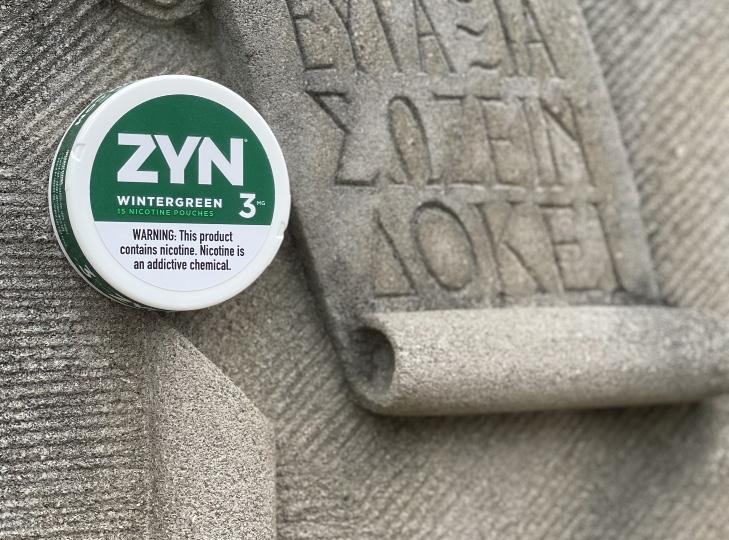
Nicotine is a stimulant drug that binds to receptors in the brain, increasing processing speed and more notably improving the mood of the user by increasing their dopamine levels. Users are quick to gain a dependence on the chemical due to its short half-life (the time it takes to flush out of the system) and because of the speed of the drug in the body.
This quick dependence is dangerous as products that contain nicotine generally have incredibly adverse side effects. Studies show that cancer, blood clots, and a multitude of other life-threatening diseases come as a result of using nicotine products.
Despite ad campaigns and other initiatives to educate the youth of America about the general harmful nature of these products, students are still using them. A study conducted by the CDC estimates about 16.5% of teens nationwide use tobacco products more than once a month.
The Haverford School is not an exception to the nationwide increase of nicotine products in teens and children.

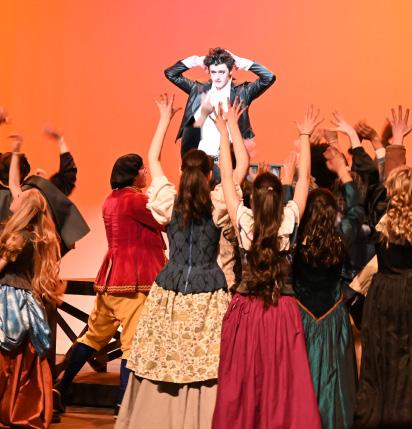
con’t on p. 3
Some students turn to new nicotine products

In balanced performance, laxmen beat Malvern 10-6

After losing to Malvern Prep in the Inter-Ac finals last year, the lacrosse team faced their rivals again in a highly anticipated match-up on Tuesday, April 11. The team was hungry for revenge, and every player stepped onto the field with a fire burning inside of them.

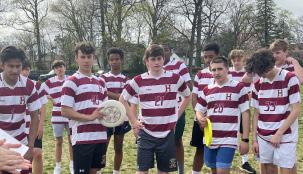
“We know it’s gonna be a battle,” Sixth Form midfielder Miles Balachandran said before the game. “At practice, we’ve been talking about staying disciplined and egoless. I think the team has really understood what Coach [Dawson] has been trying to put down.”
When the first whistle blew, the Fords clicked into high gear and were ready to dominate. Luck wasn’t on their side, though, with several near misses by Fifth Formers Will Burfeind and Brady O’Kane. When the quarter closed, the Fords were up 1-0 following a goal by O’Kane.
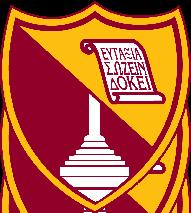
Malvern started the second quarter off strong with a goal, but Sixth Former Ryan DiRocco responded with a goal of his own. After a tough scoring drought lasting several minutes, Fifth Formers Jack Long and Brady O’Kane secured another two goals, putting the Fords up 4-1 at the half.
Malvern yet again had a fiery start to the second half with a goal from midfielder Dylan O’Connor.
con’t on p. 27
AGGARWAL
ARSH
’24
The Haverford School · Haverford, PA 19041 · April 2023 · Volume 90, No. 7 · thsindex.org the
The student voice since 1888
ZYN, a white pouch containing white powdered nictone, photographed outside the upper school
index
iPad kids, p. 21 ZACH ELDER ’23 Tennis, pg. 26 COMMUNICATIONS Fords travel to Italy, pg. 7 DR. ANDREW FENTON Frisbee, p. 27 MS. BARB LAPENTA
Billy Beifeld ’23
Ethan Lee ’24, Casey Williams ’24
PIERCE LAVERAN ’24
The lacrosse team before an April 13 win over St. Ignatius
the index
2022–2023 Staff
Jingyuan Chen ’23
Editor-in-Chief
Joey Kauffman ’23
Editor-in-Chief
Connor Pinsk ’23
Editor-in-Chief
Ethan Chan ’23
Senior Managing Editor
Owen Yu ’23
Senior Managing Editor
Ethan Lee ’24
Managing Editor
Adiyan Nayak ’24
Managing Editor
Christopher Schwarting ’24
Managing Editor
Casey Williams ’24
News Editor
Arsh Aggarwal ’24
Features Editor
Ian Rosenzweig ’24
Academics Editor
Tripp Ronon ’24
Neighborhood Editor
Connor Simpkins ’25
Campus Opinions Editor
Charlie Kiedel ’24
Off-Campus Opinions Editor
Russel Yoh ’24
Arts Editor
Tate Conklin ’24
Sports Editor
Pierce Laveran ’24
Photography Editor
Ms. Emily Harnett
Faculty Advisor
Mr. Thomas Stambaugh
Faculty Advisor
The Index is a student-run publication of the Haverford School that does more than bring news: it provides the diverse perspectives of the Haverford student body. It is an outlet for student writers to take stands on issues they deem important. It chronicles the daily struggles and accomplishments of the Haverford community. The Index also provides a forum for discussion of pertinent issues, such as student culture, academic policy, and Haverford’s place in world affairs. The Index presents new ideas and aspires to influence constructive change.
All opinions and viewpoints expressed herein do not necessarily reflect those of The Index or the school. The Index is designed and produced digitally. Photographs may be retouched. Submissions and letters to the editors regarding any and all articles are welcomed at index@haverford.org
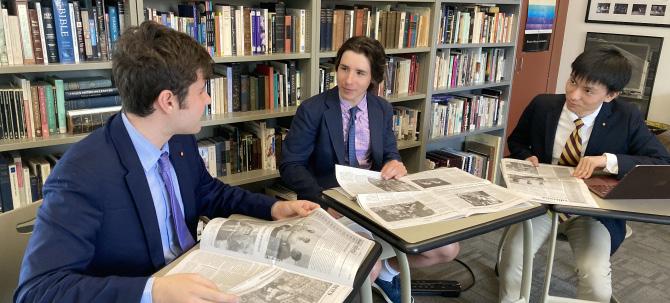
The Index, a member of the Columbia Scholastic Press Association, is composed using the applications of Google Suite and Adobe Creative Cloud. Its surveys are conducted via Google Forms and are advertised on email to current Haverford students. Graphic designs are created by Index staff via Canva. Southern Dutchess News prints 200-400 copies of each issue, and its editorial staff distributes them in the Upper School on the day of release. The Index serves the needs of a total school population of 1152 community members, consisting of 952 students and 200 faculty and staff members.
Contact The Index:
450 Lancaster Ave, Haverford, PA 19041 index@haverford.org
Twitter: @Haverford_Index

Instagram: @Haverford_Index
Volume 94, No. 7 - April 20, 2023
editorial
Stay in the game, and enjoy it
Stay healthy.
As temperature rises and the Earth laughs in flowers, the campus embraces the spring season in its full bloom.
One thing before you take off your ties and blazers and ready yourself for outdoor hobbies: hold yourself and your friends accountable for your personal health, physically and mentally.
An Index news article in this issue discusses the state of nicotine abuse in this community. As students deal with various sources of stress and anxiety, some have sought this unhealthy coping method. In severe cases, some struggle with addiction.
The Index is committed to representing diverse, authentic student voices from the community and providing channels of adult
support to improve student health.
To a wider body of students, the end to an intense season of college applications and a rise in “senioritis” has not helped increase sleep hours. From daily conversations, it appears that students continue to experience sleep deprivation at different levels. Sometimes this leads to underperformance in class and in athletics.
Reflecting off of Sixth Form Signet Member Joey Kauffman’s Reflection speech, when struggling with life, get sleep. The point is, stay healthy, and take care of yourselves.
Letter from the student body president
It is crazy to believe that it is already April, and that in less than a month the Sixth Formers will be out of the school. With the end coming near I want to convey the same message that Mr. Kolade passed down to us at the end of the first semester: finish strong. With warm weather approaching, and our minds starting wandering off about the summer we have to stay focused on this final stretch of the year.
As a student body we have done an excellent job of handling whatever’s been thrown at us. Whether that be handling the excessive amount of school work throughout the year, the student section dress coding, and the new senior assassin school policy; this year we had to take more change and adversity as a body than any other year.
I know that it’s been a difficult and challenging year, but a smooth sea never makes a good sailor. It is through adversity, and difficulties in our lives that makes us men of character. As the year draws to a close, our success will be determined by the level of commitment and discipline we demonstrate in serving our community.
Holding ourselves and each other accountable for our actions and upholding our values will be key indicators of our progress and success as the year approaches to a finish. Beginning in itself has no value, it is an end which makes beginning meaningful, we must end what we began. So as we get closer to the end, consider what kind of man you want to be. Do you want to become a better friend, brother, son, athlete, and student? The only way to achieve these goals is through putting yourself through sacrifice, whether that be cutting your time on video games, watching movies, or endlessly scrolling through your phone. Hold ourselves accountable and let’s finish this year the right way-the Haverford way. Go Fords
April 2023 Page 2 the index · editorial
COURTESY OF LUCA SEKULIC ’23
Luka Sekulić ’23
2022-23 Editorial Board (from left to right), Editors-in-Chief Joey Kauffman ’23, Connor Pinsk ’23, Jingyuan Chen ’23)
MR. THOMAS STAMBAUGH
The Index is committed to representing diverse, authentic student voices from the community and providing channels of adult support to improve student health.
Nicotine products, cont. from front page
The use of nicotine products in the school community is not a new phenomenon. What is relatively new, however, is the use of vaping and other non-tobacco products.
“My experience with vaping started about three-to-five years ago when vaping became a common term,” Third Form Dean Mr. Stephen Cloran said. “You would walk into the bathroom and smell something that seemed abnormal.”
About five years ago, the school had a vaping problem, with a large number of students using vapes in school on a daily basis. In 2017, a survey directed towards The Haverford School from the Hazeldon Betty Ford Foundation, also known as Freedom from Chemical Dependency, recorded that 23% of Third Formers, 21% of Fourth Formers, 27% of Fifth Formers, and 42% of Sixth Formers had used nicotine products in the past 30 days. The administration is uncertain as to whether or not those numbers have changed.

“I don’t have the current objective data to fully understand the extent to which it’s increased or died down significantly,” Head of Upper School Mr. Mark Fifer said. “I can say that the chatter around it has diminished.”
affect your lungs, and it’s not tobacco, so it won’t give you cancer.”
I feel the need to do something and like I end up doing it,” said the Fifth Former. “For me it was, it sort of just became instead of having a bottle of water in my hand, I’m just hitting that instead of taking a sip of my water.”
Some students even find the use of nicotine at school, particularly in secluded locations.
“If you go to [some bathrooms on campus] you will literally find [nicotine pouches] on the walls,” said another Fifth Former. “I see it sometimes in class too, and it just looks like they’re chewing gum.”
using nicotine products, the school began to try and educate students on the harmful effects of many nicotine products
Due to COVID, the administration has not conducted another survey, but some students believe that numbers have not significantly decreased. Rather, they think that the usage of nicotine has just been more underground.
“If I were to take a guess, probably around 50 percent [of the Haverford student body] have tried, if not have used [nicotine],” said one Fifth Former, who vapes regularly. “Probably 25% actively use [nicotine].”
Some believe that the usage of nicotine at Haverford remains prevalent in the form of nicotine pouches.

“I feel like [nicotine pouches are] marketed towards us—young male athletes,” said a Fourth Former who has used nicotine pouches frequently in the past. “It does not
For others, the enticing flavors of various vapes were the reason they decided to use them.
“Now it’s a lot less than I used to because I stopped using the flavor ones, and I started using the pods, which are just menthol flavored,” Anonymous Fifth Former One said. “And the flavor part I think is the biggest catch for teenagers because that’s the reason why I believe they stopped selling the flavored ones because the flavors were attracting kids, and it was something that appealed to the younger mindset too.”
In addition, some students find that although nicotine products are illegal in the state of Pennsylvania for individuals under 21, they are still easily obtainable for Haverford students.
“If you walk into the right gas station, they will just give it to you,” said the Fourth Former. “Some places just don’t card you.”
Students often begin using nicotine at social events and are introduced to it by other users.
“[A friend] was like, do you want to hit it? And I was like, you know, why not?” said the Fifth Former. “I’d never had one before and like I’ve always known I’m gonna try something of everything at one point. Not everything, but you try things every now and then.”
His experience is parallel to other students’ experiences with first trying nicotine products.
“First time I tried it, I was actually really young,” said the Fourth Former. “I had a cousin who I would hang out with a lot and for [a joke] she told me to put [a vape] in my mouth and inhale.”
Adults see curiosity about nicotine products as the main way students begin to use them.

“Curiosity leads to experimenting. All students are dealing with varying levels of stress and anxiety, and this is one unhealthy way to cope with it,” said Mr. Cloran. “Unfortunately, they lean into this unhealthy tool to cope.”
At least at Haverford, peer pressure does not seem to be a large factor in trying nicotine products.
“I wouldn’t say that people do it to look cool or like peer pressure. Me personally, with anything I have tried, have not felt peer pressured into doing it,” said the Fourth Former. “I was just genuinely curious as to why people did it, so I tried and realized there was a buzz. Some people just enjoy the buzz and do it more and more, and that’s where the problem is.”
For most of the students, the initial use was not enough to get them hooked. It took multiple attempts afterward for them to start using nicotine consistently.
“When I go to a party, I have it, and I think I hit it a lot more there. Just ‘cause I’m not a big drinker, so when I’m not drinking,
The other Fifth Former recounted a particular instance where he was offered a vape in a bathroom at school, and accepted the offer
“It was just offered to me. I wasn’t tempted to hit it,” he said. “Like, I was just like, ‘All right, why not?’”
Some students are less bold than others.
“I have never used nicotine at school. I am scared of getting caught,” said the Fourth Former. “But a lot of the time you can smell nicotine in the bathroom or you will just see guys ripping an elf bar.”
In the Upper School Handbook, the School outlines disciplinary actions against students that use nicotine products. Most notably, the school gives students with a first infraction what is essentially a second chance, allowing the student to remain at Haverford, but not participate in the community until he is cleared by the School Counselor. For students with multiple infractions and for those who sell and distribute nicotine products, the School takes a harder stance, with either case resulting in disciplinary action up to and including expulsion. Generally, the Honor Council does not handle cases involving the use of illegal substances. Cases go directly to the upper
“Every generation of students has some sort of conversation around drugs and alcohol. Mr. Fifer and the Form Deans have different people come in and talk to different grades,” Fourth Form Dean and Honor Council Faculty Advisor Mr. Jeremy Hart said. “Having people share their stories and hearing voices that aren’t [one of the Form Deans] does help.”
Mr. Hart believes that shying away from the topic is the wrong approach to dealing with student nicotine use.
“It’s a continual conversation. Part of what we do here at Haverford is the mission statement, ‘preparing boys for life,’” Mr. Hart said. “Giving boys here the information
school office.
Despite students keeping the products hidden from teachers and other adults, the administration was quick to realize that there was a large number of students using nicotine products.
“As educated people will do, they will put two and two together, reading articles and watching the news, and discuss,” Mr. Cloran said. “Also as a parent, you hear about vaping. That led to the administration keeping an eye out.”
To combat the increase of students
to make decisions is of vital importance.”
Mr. Cloran also attributes the decline of vaping at Haverford to conversations and education.
“I think the experts have shared their studies more and there has been more education about the unknown factors of vapes,” Mr. Cloran said. “Young people have had health emergencies from vaping and those news clips and information from the media trickles down to the students and scare and educate them on using nicotine products.”
A member of the class of 2019 smokes a cigar after his graduation
“If I were to take a guess, probably around 50 percent [of the Haverford student body] have tried, if not have used [nicotine].”
COMMUNICATIONS news the index · news April 2023 Page 3
ANONYMOUS FIFTH FORMER ’24
“Curiosity leads to experimenting. All students are dealing with varying levels of stress and anxiety... Unfortunately, they lean into this unhealthy tool to cope.”
MR. STEPHEN CLORAN
The faculty also discuss student use of nicotine products.
“We do in faculty meetings have conversations about prevention,” Mr. Fifer said, “Basically, we are providing faculty with information so that they are prepared to intervene if they suspect student use.”
Including nicotine use, especially in the form of vaping, in the tobacco policy of “The Upper School Parent-Student Handbook,” and allowing students to be safely curious about these products is the main way the administration has been handling this issue. The Handbook outlines strict punishment policies for students using nicotine products. Additionally, the increase of the legal smoking age from 18 to 21 has also helped in dissuading students from vaping, as it is now harder to get tobacco products. Despite this, many locations still sell to people under the age of 21.
“Having those conversations, like with [FCD], is important, but it is more important that these conversations are not one-off,” Mr. Hart said. “It’s important for students to be able to ask questions in an environment where they don’t have to fear retribution or punishment for their questions.”
Mr. Hart also realizes the importance of also monitoring these conversations.
“There could be more space for student-led discussions, but I also think that authentic student conversations can stray negative in private spaces,” Mr. Hart said. “Finding a way to leverage student leaders to
lead these conversations is key.”
Haverford provides curriculum from the Freedom from Chemical Dependency Group, incorporates information into the health curriculum starting in the First Form, and provides assemblies with medical and addiction professionals. The administration and teachers view educating students on nicotine products as the main way to combat student use.
“When you are educated on something, that’s power,” said Mr. Cloran. “When we receive valid and reliable education, we tend to choose healthy choices.”
One initiative constantly highlighted by Haverford is the Brother’s Keeper program.
“The largest piece that we have is the Brother’s Keeper program, which tries to get students to intervene if they think that one of their friends has an unhealthy relationship with a substance,” said Mr. Fifer.
The Brother’s Keeper program was initiated several years ago to encourage students to refer their peers to the administration if they believe they are struggling with drugs or alcohol.
The “Brother’s Keeper Card,” a physical card provided to all Haverford students encouraging the program, states that “The School will not pursue disciplinary action but instead will bring information to the student, without naming its source, and will confidentially provide him with any resources and support he may need.”

“If there is a student who has a friend or peer who they think has a complicated relationship with drugs and alcohol, they can call the number [on the Brother’s Keeper Card], and it’s strictly a supportive framework,” said Mr. Fifer. “There’s no disciplinary intervention.”
Some students who have struggled with nicotine addiction find it either difficult to seek help or don’t believe that they need help.
“Obviously a lot of people go through withdrawal when they stop using certain types of drugs, and nicotine is definitely one
of them,” said the Fifth Former. “They get all jittery, and they feel like ‘I need to hit it.’”
The Fifth Former has had some impulses to use nicotine.
“I went on vacation recently for a week and one night I had the urge to hit it, but I didn’t have it on me,” he said. “But then after that, I went downstairs, and I was hanging out with my family, and it went away. When I’m distracted, I have no urge to hit it.”
Some students find it easier to quit.
“I never really had that bad of a problem with [nicotine] but one time I got really sick and I just never wanted to use it again,” said the Fourth Former.
In terms of the health effects of using nicotine, some students have noticed negative implications.
“I have asthma and like, it’s not severely bad, it’s just there in the winter. I start to feel a kick in if I were to run or something like that,” said the Fifth Former. “And using it after, I think after like two months of using it, I started to realize my shortness of breath. And now I can’t take as deep a breath as I used to be able to really.”
Students who have friends who also use nicotine notice negative respiratory effects as well.
“I’ve seen people who have used it,
especially my friends who I bike with,” said a different Fourth Former, who doesn’t use nicotine, but has friends who do. “Slowly their biking became slower and slower and slower until they almost couldn’t breathe.”
Other students see no reason to start as they know the risks of some of these nicotine products.
“I would never consider using it. I know it’s bad so I am not going to use it,” said Anonymous Fourth Former Three, who’s never tried nicotine before. “If a friend told me to smoke, I would probably say no.”
Students at Haverford are aware of the health repercussions and negative implications of using nicotine products through educational opportunities and outreach programs.


Despite this, students often find themselves struggling with addiction, feeling isolated and without support. However, the difficult step of making an effort to reach out to a friend or trusted member of the community is essential in avoiding adverse health effects and addiction.
“Like I think everyone thinks like I’ll stop at some point,” said the Fifth Former. “But it’s just a matter of actually doing it sooner than later because if you don’t do it now, it’s never gonna happen.”
Nicotine, con’t from
previous page
the index · news April 2023 Page 4
A vape pen in a school classroom several years ago
“When we receive valid and reliable education, we tend to choose healthy choices.”
MR. STEPHEN CLORAN
JOHN WILLIAMS ’19
MR. THOMAS STAMBAUGH Brother’s keeper card
The Notables return from an eye-opening Denmark travel
After more than four years, the Notables returned to Copenhagen, Denmark to tour and share their voices with the Danish people.
During spring break, the Notables, Baldwin B-Flats, and a few students who hosted Danish students in October flew to Denmark and spent a week performing and experiencing what Copenhagen had to offer. They performed at a variety of destinations—castles and churches from the 12th century, to name a few—but also lived in a culture vastly different from the United States.
Sixth Former Isaiah Schuchman described Denmark as a city characterized by picturesque architecture.
“I really expected it to be European, which I got, but I feel like the buildings were a lot smaller than I expected. I was expecting it to be more like London, but the buildings were small and quaint, which I really enjoyed.”
“Denmark is a beautiful place,” said Notables Director Mr. Matt Mastronardi. “It was very much like I had pictured it in my head, but it was even nicer when I got there. Everything was so clean, and the people did not seem to be in a rush or stressed.”
The Notables and company traveled through and around the city, exploring the shops, attractions, and restaurants. All were surprised and impressed by the various methods of travel and the efficiency of public transport.

“I wasn’t expecting as much development around the canals, but they were a very integrated part of Copenhagen,” Shuchman said. “[The public transport system] is pretty hard to beat and something like that in our area would be incredible.”
Sixth Form Secretary of the Notables, Julian Caesar, was surprised to see the prevalence of biking. “I was surprised to see the bike lane take up the majority of the sidewalk. While we were there, it was almost as
if bikes were treated with a higher priority than pedestrians.”
They used the incredible public transportation to travel to even more destinations to perform and learn about Denmark’s rich cultural heritage and history. One of these destinations was the 12th-century Lyngby Kirke.

“We had a great flow and were in the zone. It was nice to just focus on singing together as a group for that week, and not have to worry about all the other million things we do here at home,” Mr. Mastronardi said. “Our hard work in learning all those songs and preparing for these performances really paid off.”
“Due to the long history of the Notables and the B-Flats going to Denmark and performing for the Danish people, it felt as if we were almost celebrities,” Caesar said. “Each time we performed the quality of our songs and the applause increased respectively.”
They also had the opportunity to see what school in Copenhagen was like.
“I did not expect as much focus on mental health and alcohol moderation in
their school,” Caesar said. “I came across both a seminar and class that focused on those topics.”
But above all else, the Notables were thankful to spend time together.
“I feel like being in Denmark was not only a great opportunity for the Notables to get closer with one another on the trip, but it was also a great opportunity for us to bond with the Baldwin B-Flats,” Caesar said.
Mr. Mastronardi agreed. “We had some of the best performances of the year there. It was incredible to be somewhere new and feel like rock stars for the week. I am hoping we continue with that newfound strength as a group throughout the rest of this school year.”
“The church is set up on this hill. It looks like it came from a fairytale,” Mr. Mastronardi said. “It was a magical night. The church’s acoustics really enhanced our singing, and it was the first time we got to perform all the songs we prepared to sing with the Baldwin B-Flats!”
Another fascinating stop was Kronborg Castle. “The weather was rainy and cold, which really fit the vibe of Hamlet,” Shuchman said.
Caesar echoed this sentiment. “From the on-the-spot performances in the neighboring cafe and in the castle itself to getting a chance to get a tour of the castle, my favorite place to visit was Kronborg.”
“It truly is incomparable to here in Philadelphia,” Sixth Former and Co-President of the Notables Harvey Pennington said. “It was really eye-opening to see how different the culture was compared to some cities here.”
Their performances, the Notables agreed, went especially well.
Elliot Lee ’25
the index · news April 2023 Page 5
The Notables perform “Moondance” in a flashmob-inspired performance on the streets of Copenhagen
COURTESY OF MR. MATT MASTRONARDI
“The church is set up on this hill. It looks like it came from a fairytale. It was a magical night.”
MR. MATT MASTRONARDI
Notables perform with the Baldwin B-flats at Lyngby Kirke in Denmark COURTESY OF MS. BARBARA LAPENTA
Community reacts to Donald Trump’s indictment
On March 30, 2023, a grand jury in Manhattan indicted former President Donald Trump. On April 4, Trump was charged with 34 counts of falsifying business records. He pled not guilty to each.

The indictment alleges that Trump falsified business records in his supposed reimbursements to lawyer Michael Cohen after Cohen made a “hush money” payment to adult actress Stephanie A. Gregory Clifford, known professionally as Stormy Daniels. Cohen served about a year in prison in 2019-2020 after having pled guilty to violating federal campaign finance law with a $130,000 payment to Daniels. The indictment claims that the Trump Organization recorded its reimbursements to Cohen as legal expenses.
Daniels says that she had an affair with Trump. The hush money payment was made in 2016, just before the presidential election, and Cohen claims that Trump directed him to manage the payment to Daniels. Cohen and Daniels were witnesses in the grand jury hearing at which Trump was indicted. The credibility of Cohen’s testimony in particular has been called into question because of his criminal past.
gin,” Sixth Former Isaish Shuchman said. “And I don’t think most people who know a decent amount about the legal system in our country would jump to that conclusion of this being a weak case either.”
From the foundations of the indictment to the validity of the case itself, opinions vary widely. The former president is polarizing, underscored by the nation’s split reaction to his charge. Reactions have also been mixed in the school community. However, students from both sides of the political spectrum have indicated a belief that the indictment was justified, despite potential political motivations or “convenient timing.”
“I do believe that the indictment
or hurt his public image.
“Being President is an important responsibility, and yeah, that might mean that people look a little closer at the things you have done and they might hold you to a higher standard,” Schuchman said. “Though in a criminal case, it’s not even a higher standard, just the same one that you or I might be held to. That’s a good thing.”
Whether or not the indictment is legitimate remains a subject of heated debate. A CNN poll found that 60% of Americans support the indictment, but while 94% of Democrats are in favor, 79% of Republicans oppose it. A Quinnipiac poll found that 93% of Republicans and 70% of Independents believe that the indictment was political, while 66% of Democrats said that it was motivated by the law.

“I doubt that it is apolitical and that the D.A. was influenced by anti-Trump sentiment in pursuing it as vigorously as he is,” Pryma said. “Though, I still believe [Trump] would’ve gotten into some legal trouble eventually, regardless of his political career.”
“It’s hard to think of an achievable solution. An equal number of left- and right-leaning people would just lead to a hung jury, and finding a completely unbiased jury is difficult. But, for one of the nation’s most important trials, I think it’s possible.”
was absolutely justified; the evidence suggests that he committed a crime, so he should be indicted,” Fifth Former Reilly Pryma said.
“It seems to me that there is sufficient reason to indict President Trump, but the timing doesn’t seem right,” Fourth Former Harrison Brown said. “To me, I do not understand why this information is just coming out now as the incidents occurred about seven years ago.”
Justified or not, the indictment is simply a formal accusation of crime—not a conviction or sentencing. Trump maintains his innocence and will fight the charges in court over the coming months.
As New York prosecutors begin their case in court, similar considerations of political motivations will unravel. Selecting a jury of peers to decide Trump’s case will prove difficult.
“I think it will be extremely difficult to hold a fair trial, considering how politically polar our country has become,” Brown said.
Fourth Former Tommy Saul believes that finding an unbiased jury will not be “entirely possible.”
As news cycles focused on the indictment, Trump’s popularity among Republicans actually grew. He leads by an even larger margin in Republican primary polls in mid-April than he did in mid-March. Postindictment, Reuters reported a 4% increase in self-described Republicans who want Trump to claim their party’s nomination, while his nearest rival, Florida Governor Ron Desantis, lost over 10% of supporters in the same time period. Similarly, FiveThirtyEight reported that Trump’s lead over Desantis grew from ~8% to 26% in a Yahoo News/ YouGov poll.
Members of the Haverford community have also expressed concern over the witnesses.
“The credibility of the sources is important, but I do not believe that the [District Attorney Alvin Bragg] would have brought this case forward if it was just a case of hesaid-she-said from witnesses of dubious ori-
In addition to his plea of “not guilty” to each of the 34 charges, Trump has made numerous statements both denying the charges and delegitimizing the case. Some of his comments on his social media platform, Truth Social, include, “ALVIN BRAGG SHOULD BE HELD ACCOUNTABLE FOR THE CRIME OF ‘INTERFERENCE IN A PRESIDENTIAL ELECTION’” and “THE WITCH HUNT NEVER ENDS.” Trump has frequently referred to investigations into him as “witch hunts,” suggesting that they are partisan efforts to discredit him
“At some point, [jurors’] subconscious bias[es] takes over. But, I believe most try to remain in an unbiased standpoint,” Saul said.
Pryma took a more optimistic view but still noted the challenge.
“I believe that it is possible to find an unbiased jury; there are a decent number of apolitical people out there. However, in this age of information being spread everywhere and that information becoming more and more polarized, it would be incredibly difficult to find a fully unbiased jury, especially for a figure like Trump,” Pryma said.
Although increased support after a criminal indictment may seem odd, it is demonstrative of the polarized state of the United States and of Trump’s powerful populism. The conviction doesn’t seem to have changed many opinions about Trump. Rather, it has
“We’ve reached a point in American political discourse where a certain side tends to believe ‘If I didn’t win, it was rigged.’”
served as a rallying point for Trump supporters and just another reason for those who dislike the former president to oppose him. The polarized viewpoints showcased by both polls underscore changes in American sensibilities.
“We’ve reached a point in American political discourse where a certain side tends to believe ‘If I didn’t win, it was rigged,’” Shuchman said. “When you have large media corporations and the same populist elected officials on that side amplifying this voice, and those voices are in an echo chamber, it’s understandable how a lot of people believe that.”
Like the rest of America, the student body is split over Trump. An October 2020 Index poll of 128 upper school respondents showed that 48% of students supported Trump and 41% supported now-President Joe Biden in the 2020 election.
Even if a potential Trump conviction does not seem to influence the community much, his situation—frequently discussed in the media—will remain intertwined with the student body’s political engagement.

Ian Rosenzweig ’25
VIA WIKIMEDIA COMMONS
“I think it will be extremely difficult to hold a fair trial, considering how politically polar our country has become.”
HARRISON BROWN ’25
the index · news April 2023 Page 6
ISAIAH SHUCHMAN ’23
NYPD officers standing next to protesters at Trump Tower on March 21 2023
“I believe that it is possible to find an unbiased jury.”
REILLY PRYMA ’24
Italy travel-study promotes academic passion
Over spring break, a group of upper school Latin students traveled to Rome, Italy. More than a simple bonding trip, the ten-day visit aimed to enhance the study of Latin in both language and culture while pushing the students out of their comfort zones.
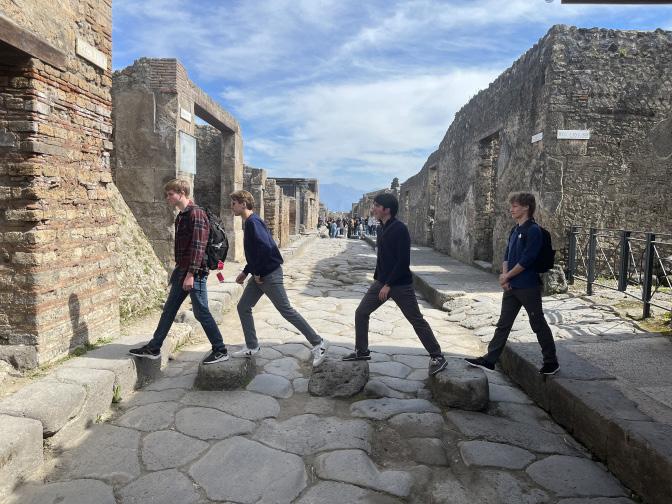
The travel-study was loaded with activities, many of which included the observation and examination of classic Roman architecture.
“My favorite part of the trip personally was when we went to Pompeii, because it was really cool to be in the old city,” Fifth Former Ben McComb said. “Another cool part was when we went to St. Peter’s [Basilica], and we went all the way up to the top of the dome.”
“We visited a lot of really famous and really impressive monuments. Out of all of them, the one that stood out to me the most was the Pantheon.”
Visiting the historical structures gave the students a greater appreciation of just how magnificent ancient architecture can be.
“We visited a lot of really famous and really impressive monuments. Out of all of them, the one that stood out to me the most was the Pantheon,” Fifth Former Nolan McCloskey said. “It’s a massive structure, and it really makes every other building around it, even modern buildings, pale in comparison. It’s majestic and huge, and it was a great sight
to see.”
As the group quickly learned, the statues were not there for spectacle alone, with each one containing a rich history and complexity.
“I think that going to see all these amazing statues and monuments really helps to give you a sense of the time period, and what things would have been like, that you can’t get just by looking at a photograph.”
NOLAN
’24
“We also saw the statue of the boxer, which we had seen in class previously. It’s one of the first examples of Hellenistic art, and it’s really quite a masterpiece, so getting to see that up close was amazing,” McCloskey said. “I think that going to see all these amazing statues and monuments really helps to give you a sense of the time period, and what things would have been like, that you can’t get just by looking at a photograph.”
Another academic activity during the travel-study was one familiar to Latin students: translating.
“It was interesting to translate Latin that was actually there in the places. On the obelisks and other statues there were inscriptions that we got to translate, which was pretty interesting.”
Translating Latin in Rome itself provided a fresh variation on Latin class routines, and the students were able to appreciate the value of learning on-site.
“We were able to translate inscriptions that remained on the monuments or had been put next to the monuments, and that helped link these amazing structures and statues to all the historical moments that we’ve been learning about in class, in a way that’s impossible by just pulling it up on a
Google Doc,” McCloskey said.
Students returned home feeling fulfilled with the program and that the trip was worth the investment.
“It was a great time. Academically you learn a lot, but you also get to do it with your friends, which makes it more fun,” McComb said. “You get to see some pretty cool stuff while learning at the same time.”
It was a memorable ten days for the group, and many are hoping to see more school travel opportunities in the future, which may help to ignite some of the passion that drives an academic environment.
“I was surprised by how much all the students enjoyed the trip,” McCloskey said. “Everybody got really into all the historical aspects of what we were doing, and it really was a valuable educational experience for all of us.”
3D Art II* students exhibit mural in dining hall
Recently, you may have noticed a change in the dining hall. The old ceramic mural has been replaced with a newer, much more modern piece of woodwork, featuring a shield and a wooden textile pattern with the school’s colors. This piece was a collaborative project between Fifth Formers Ethan Lee, Tripp Ronon, Quintin Bowers, and Sixth Former Henry Gowen.
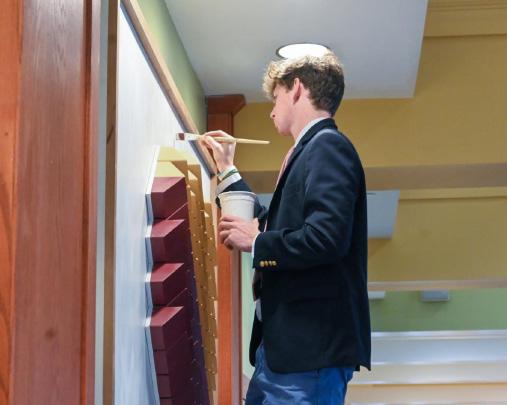
The piece itself represents this variety, with a combination of individuality at the bottom and a symbol of togetherness under the shield.
particular is what made the project so fun and successful,” Bowers said. “Everyone worked very hard and helped add something to the final design.”
“Even though we didn’t have a set plan going into it, the fluid design process led us to an end result that we were all happy with.”
QUINTIN BOWERS ’24
The project in total took around three to four months for them to create and place each piece to satisfaction.
providing a nice addition to the space.
“My favorite part about this project was probably ripping music on the speakers during class to keep the vibes up,” Bowers said. “Even though we didn’t have a set plan going into it, the fluid design process led us to an
end result that we were all happy with. I feel like the most important thing that I got out of this project wasn’t the work itself, but the memories that I made with my friends in the studio.”
QUINTIN BOWERS ’24
The group’s original goal for the project was to make something that would last at the school, leaving a legacy behind after their graduation next year, even if they started without much of a plan.
The piece has been in the dining hall for a little over the past two weeks, and it brings a fresh aura to the room and area around it,
“Working with this group of guys in
Adiyan Nayak ’24
Students visited Pompeii during travel-study to Rome, Italy during spring break.
Quinn Sulivan ’25
Henry Gowen ’23 puts the finishing touches on the new mural.
“Working with this group of guys in particular is what made the projoect so fun and successful. Everyone worked very hard and helped add something to the final design.”
COURTESY OF COMMUNICATIONS COURTESY OF DR. ANDREW FENTON features the index · features April 2023 Page 7
NOLAN MCCLOSKEY ’24
MCCLOSKEY
“It was a great time. Academically you learn a lot, but you also get to do it with your friends, which makes it more fun.”
BEN MCCOMB ’24
Do students still read for fun?
Luke Ganley ’25
In the age of technology and social media, how could a book possibly keep a student’s attention? Have books lost their appeal in favor of movies and TV shows? Despite what many may think, in the face of all these attention-grabbing media, many students still choose to read.
While students may not physically be checking books out of libraries like they used to, but they are still reading other forms of text.
“There’s a significant drop in checking out books, but I don’t know if that means they’re not reading,” Head of Information Services Ms. Lisa Snyder said. “From my end, it looks like there is, but you also have so much that’s [digital].”
Although there aren’t many students checking out books, Ms. Snyder believes that, because students have so many resources available to us such as Kindles and e-books, students do continue to read.
Previously, students who enjoyed reading could join Reading Olympics, a club where students are given books to read and
compete later in the year to answer questions from each book. However, recently, the club has dwindled.

“We started Reading Olympics four years ago in the upper school,” Ms. Snyder said. “Jeffrey Yang [’22] came up from the middle school and wanted to start a team, so the first year we had face-to-face competitions. But since the pandemic the competitions haven’t been face to face, and they’re not really as fun. It’s hard work, and the fun part was the competition at the school. So we didn’t participate this year,” Ms. Snyder said.
While interest amongst upper school students is small, the club is popular in other divisions.
“We participate in the lower and the middle school. We had forty kids on the team in the lower school, and I think this year we had nine in the middle school,” Ms. Snyder said.
While hope isn’t lost yet on students’ passion for reading, social media is surely taking some of it away. With short-form content taking over screens across the world, students have gravitated to similarly-paced literature.
“Right now, manga and graphic novels [are our most popular genres], I think because it’s a quicker read, you know, and you can get through a full story,” Ms. Snyder said.
Fourth Former Avery Jones, an avid reader of manga and fantasy, enjoys these genres for their imaginative value.
“I just think it’s because I like magic a lot,” Jones said. “Fiction is so wonderful because you can create whatever world you
want, so I don’t really like books that build off of the planet we already live on.”
Ms. Snyder has also noticed a trend of students becoming more interested in literature as they near college.
“But also we get seniors, as they get a little bit older, they start to become more interested in sort of the literature of the adult,” Ms. Snyder said. “They’re like, ‘Oh, I want to read Outliers,’ or ‘I want to read something like The World is Flat, some kind of book like that.’ Some kids compile their own college reading lists, like this is what I want to read before I go to school. We have some really strong readers, but we also have people who probably don’t crack a book, who, hopefully, are reading [on their devices].”
English teachers like Dr. Micah Del Rosario have also noticed a decreasing interest in independent reading from students.
“I have had in my time here, which is three years, not that long as far as Haverford teachers go, two students who have asked me for reading recommendations,” Dr. Del Rosario said. “Both of them took those recommendations, read the books, and I was able to chat with him afterwards. It was great, but that’s two students. So generally speaking, I would say not that many.”
Even with a long list of books Dr. Del Rosario is able to recommend, not many students in his classes are familiar with any of them.
“I would say for instance, like with Heart of Darkness, I had one sophomore saying that he was familiar with that book and read it. I think that’s fair, because I think the question of ‘Do they recognize the book when I mentioned it?’ is like, well, are we talking about? This is kind of a facetious example, but it’s like Twilight versus Crime and Punishment Of course, there aren’t many eighth graders who go around reading Joseph Conrad,” Dr. Del Rosario said.
He also said that the quality of writing between those who do and do not read is apparent. He said that it’s a “foundational truth,” and “basic reason” as to why you should read. He continued to say, however, that it doesn’t seem like there is much reading being done if not for a class.
“My perception is that there’s not much recreational reading that goes on,” Dr. Del Rosario said. “I don’t know that I would really say that that’s a Haverford thing so much as a Gen Z thing, just growing up in a world that’s so technology heavy.”
Faculty members create “Gorilla Squash” game
Finn Tierney ’25
Every Friday morning a group of faculty plays squash in the athletic building. Their version is a game they call “Gorilla Squash.” The name describes the tendencies to hit the ball as hard as possible with little regard for traditional squash strategy. The group shares a Spotify playlist and there are hundreds of songs on there from all different types of genres and singers. The group first started barely five years back when Mr. Jesse Sataloff and Mr. Jeremy Hart wanted to learn how to play, compete a little bit, and get a good sweat in on Friday mornings at the end of a long week. They have been playing ever since and the group started to grow more this year. At the beginning of this year Mr. Sataloff retired from morning squash, and Mr. Keith Belson and Mr. Hart invited Mr. Jeremy Fus and Mr. Jonathan Bacon to join the group.
Each faculty member brings his own unique flavor to the court.
“Mr. Bacon is king of just-above-theline shots that just die,” Mr. Hart said. “Mr. Fus is unorthodox and keeps you on your
toes... much like his math class.”
When watching the group, it was clear cut that the most talented player was Mr. Andrew Poolman. He won games, sometimes playing with his opposite hand. Mr. Hart compared him to Roger Federer, noting his effortless play. Although no one has beaten Mr. Poolman; Mr. Hart came the closest, once bringing a game to 9-7.
“Honestly though, [Mr. Poolman] has helped us all get better by modeling how to play the right way and giving us little tips here and there,” Mr. Hart said. “Gorilla Squash is hard to get out of your system entirely.”
Despite the competitive nature of squash, it is a great time full of laughs and smiles.
 The quiet stacks of Severinghaus Library
Mr. Keith Belson in early morning play on April 14
The quiet stacks of Severinghaus Library
Mr. Keith Belson in early morning play on April 14
FINN TIERNEY
the index · features April 2023 Page 8
PIERCE LAVERAN ’24
’25
With short-form content taking overscreens across the world, students have gravitated to similarly paced literature.
Despite the competitive nature of squash, it is a great time full of laughs and smiles.
Robotics team 169A adapts for World Championships
Robotics, just like any other sport or activity, is based on the idea of improvement—more so than many other activities. Building a complex and intricate machine and finding flaws in the basic structure can be an infuriating but important process.
Imagine screwing in screws, nuts, and bolts, often for up to fifteen hours a week, just to go to a competition for it to fall apart tragically. Rebuilding is at the core of the robotics process. Learning from your mistakes and from others’ successes may seem tedious, but it builds skills engineers will need for the rest of their lives.
Currently, team 169A, the most experienced team in the school’s shop, is preparing to set foot on the biggest stage of robotics in the world, the Worlds Competition in Texas. As they prepare to finish their season, 169A’s members work towards improving their robot to match the level of competition they will meet.
Sixth Former Megh Tank feels that the season has presented a long process of failure and learning, all leading to this moment.
signs and changing concepts like new designs and new code. Some difficulties this year though were that our start was really slow, teams [in the Haverford shop] were a little different this year, and getting that team bonding experience,” Tank said. “Coming back from last year’s upsetting season and not doing as well as we wanted to, and trying to pick up the pace this year, we started out kind of slow and faced a lot of difficulties.”
Tank, renowned in the shop as an experienced builder and pneumatics expert, can attest to the difficulties the whole team faced this season, in terms of this year’s game.
Vex Robotics has a long-lasting tradition of creating unique games for each season, a factor that keeps young robotics enthusiasts on their toes.
Vex Robotics has a long-lasting tradition of creating unique games for each season, a factor that keeps young robotics enthusiasts on their toes.
This year, the game, called Spin Up, involves many individual working parts and functions that came together to build a very complex robot. The game allows drivers to score points by either shooting discs into a goal resembling that of a frisbee golf goal, turning cylinders to their team’s color, and shooting string across the field tiles in the finale of the game to rack up even more points.
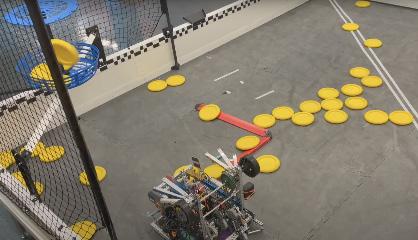
These factors, coupled with the many limitations VEX details in its rulebook, such as a maximum of eight motors and some size restraints, created tough competition, especially for newer members.
Many of the robotics team members were inexperienced this year. They used guidance from the club’s Sixth Formers to learn and adapt, skills they will utilize throughout their robotics careers.
Many of the robotics team members were inexperienced this year. They used guidance from the club’s Sixth Formers to learn and adapt, skills they will utilize throughout their robotics careers.
Fourth Former Elliot Lee, a new but skilled member of the club, thinks the team can improve in a number of areas.
“We could have managed our time better and set more realistic goals, especially for our competitions like [the one in] Wisconsin, where we made an extremely ambitious rebuild, which didn’t exactly work.”
ETHAN LEE ’24
“We could have managed our time better and set more realistic goals, especially for
our competitions like [the one in] Wisconsin, where we made an extremely ambitious rebuild, which didn’t exactly work out,” Lee said.
Going into the next season, Lee hopes to learn from this season. Not many high school students learn to set specific and achievable goals within accurate time frames, but those who do get a head start on the next season.
Lee said, “Next year we want to win States.”
Instead of aiming straight for Worlds, the highest and most prestigious level of Vex Robotics, the team will look to solidify their position in their region.
As their season comes to an end, the Sixth Form members of the club look to finish well.
As their season comes to an end, the Sixth Form members of the club look to finish well. The World Championship competition takes place from April 25-May 4 in Dallas, Texas. The event will be webcast online.
Conor McDonald, another Fourth Former, said, “We are rebuilding our intake and catapult, which are the two main systems of the robot, and we are building this new bot with red and medical gray anodized aluminum.”
Even though McDonald and Lee are the youngest students on the 169A robotics team, they have learned the difficult skills of revising, taking steps back to make forward progress, and adapting to the slow but rewarding process.
“I think we did really well adapting to what the season threw at us, reiterating de-
Robotics set up outside Ball Auditorium
COURTESY OF THE HAVERFORD ROBOTICS TEAM
Milan Varma ‘25
“Coming back from last year’s upsetting season and not doing as well as we wanted to, and trying to pick up the pace this year, we started out kind of slow and faced a lot of difficulties.”
academics the index · academics April 2023 Page 9
MEGH TANK ’23
Speech and Debate experiences its most successful year
Last year, few believed that much would be accomplished by a twoman speech team and a slightly larger debate team. Just a year later, the Speech and Debate Team has reached new heights. The weekend of March 17, the team competed in the state tournament at Bloomsburg University, with Fourth Former Charlie Noble going all the way to the semifinals in the Impromptu Speech category.
The trend continued leading up to the state tournament, starting with the qualifiers. Aside from participating in many previous tournaments to even qualify for the state tournament, Charlie Noble broke from the preliminary rounds in Impromptu Speech and made it to the semifinals. Noble is the first Haverford student to achieve that milestone for his event, earning him seventh in the state.
“I’ve been a coach for nine years,” Spanish teacher and Debate coach Mr. Javier Lluch said. “As long as I’ve been here, this is the best we’ve ever done.”
Prior to the state competition, Fourth Former Mason Wiegand reached the quarterfinals for Extemporaneous Speech at the Pennsbury Tournament, the furthest point a Haverford student had gained in that competition. This success marked the start of Haverford’s best season in speech and debate in recent years.

“There’s a lot more pressure when you’re at a bigger tournament. There are also a lot more people at the big tournament. There were just five people with us [at local competitions] and then at the big tournament it was over 30 competing in our group,” Noble said. “You have to place in certain positions to give yourself a chance, so it’s just a lot more knowing about where you have to place in certain rooms.”
The tournament took place over two days at Bloomsburg, two hours northwest of campus. This was the first tournament since the COVID-19 pandemic.

dents from various schools, these trips also require exercising social skills as members meet new people.
“If one team qualifies, we can send a bunch of kids to the open events, so yes we will [do this again in the future],” Mr. Lluch said.
Still, it is not certain if Haverford will qualify again for the state tournament, especially with more schools entering next year.
Haverford to do very well in one of these tournaments at any point if we get people who really want to give it their full effort,” Noble said. “You may not see yourself doing it, but that’s the same place that I was in last year. I didn’t know if I was going to do it, but I decided to give it a try.”
Nearly six months later, Noble sees himself as the seventh-best impromptu speaker in the state.
“It was absolutely worth it. For me personally, as a judge and a coach, I always get to judge really, really good rounds,” Mr. Lluch said. “It’s one of the things I definitely missed about doing things in person.”
“It was an enjoyable experience because it’s something different. And it made me have to get out of my comfort zone,” Noble said. “I have to learn how to be around people, so it’s just one of those experiences that will help you later in life.”
Aside from competing with other stu-
A throwback to 1927 The Index in


“[Lincoln Douglas] has one person, but he’s committed, but the [Public Forum speakers] need to be a little more committed,” Mr. Lluch said. Lincoln-Douglas speech—an event in which two students directly debate each other on a world topic— currently has one committed student: Sixth Former Jingyuan Chen. With Chen graduating in June, someone will need to fill this role.
Mr. Lluch said, “We need more students and probably more committed PF [Public Forum] debaters.”
With such a great season, the team would like to repeat and improve this year’s results.
“There’s always an opportunity for
“If we had many other students that decide to just try something new, then we would definitely be doing way better at these tournaments,” Noble said. “Part of doing really well is just getting more people involved.”
LUCA ALOI ’25
the index · academics April 2023 Page 10
Charlie Noble recieves an award after a state tournament performance
“As long as I’ve been here, this is the best we’ve ever done.”
MR. JAVIER LLUCH
Luca Aloi ’25
“There’s a lot more pressure when you’re at a bigger tournament. There are also a lot more people at the big tournament... It’s just a lot more knowing about where you have to place in certain rooms..”
CHARLIE NOBLE ’25
“It was absolutely worth it. It’s one of the things I definitely missed the most about doing things in person.”
MR. JAVIER LLUCH
“Part of doing really well is just getting more people involved.”
CHARLIE NOBLE ’25
The 1927-28 Index Editorial Board
The Index in December 1927, volume 33, No. 3
The school spirit section on the December 1927 issue
neighborhood
The Manayunk-ification of Ardmore

Tripp Ronan ’24
The Ardmore Master Plan is a comprehensive and far-reaching proposal for the future of the Main Line town. Drafted by a Lower Merion Township Steering Committee, the plan proposes an updated Historic District which would emphasize pedestrian walkability, introduce bike lanes, and create new public spaces. The three main goals are “Strong Economic Vitality, Vibrant and Sustainable Public Realm, and Safe and Convenient Multimodal Connections.”
The proposal gives pedestrians more control over the busy streets. Raised intersections, curb extensions, and crossing islands would be placed on Lancaster, Montgomery, and Ardmore Avenues. Narrower driving lanes would promote slower car speeds, and speed humps and raised medians would calm traffic. Schauffele Plaza, which is currently used as a parking lot for establishments such as Bella Italia Pizza and Tired Hands Brewery, would be turned into a park meant for community gatherings and public events.
Bicycle transportation is also highlighted in the plan. An idea for a redesigned Rittenhouse Place has bike lanes that would connect to the ‘Downtown Ardmore Bike Loop’ that circumnavigates the Historic District. Bikesharing and e-scooters are mentioned briefly in the plan as well, despite the fact that rideshare e-scooters are effectively banned in Pennsylvania.
“I don’t understand it—Ardmore does not have a bike culture,” Fifth Former Michael Wylie, a lifetime resident of the town, said. “A place like Havertown has a huge bike culture, but not here. Bike lanes are fine, I just don’t know who would use them.”
Math teacher Ms. Barbara LaPenta, an Ardmore renter, is worried about some of the proposals on the Master Plan.
“I’m not opposed to the traffic and safety changes, but my concern is parking.
A lot of businesses suffer because of parking issues,” Ms. LaPenta shared.
Wylie, a Bella Italia regular, has struggled to park near the pizza restaurant.
“I have to park very far away because that parking lot is always filled. If that parking lot was turned into a community space, I would probably have to park even farther away,” Wylie said.
Despite having to walk farther for his pizza, Wylie would be able to enjoy his slice in the newly created adjacent park.
There is concern in the community that there is presently not enough parking, yet the Ardmore Master Plan proposes even less parking. Part of the plan is the creation of a Transit Overlay Zone, an area “to allow higher density mixed-use development within a ten-minute walk of Ardmore Station.”
This designated space would increase density, raise building heights, and decrease parking requirements. The logic behind this zone is that living closer to the Ardmore Train Station would encourage the use of public transit rather than automobiles.
“Even if you take the train every day, you still probably own a car if you live in Ardmore. It doesn’t make sense to make an area more populated and not have enough parking,” Wylie said. “If you have a denser area to bring in more people, you need enough parking spaces for those people.”
The Transit Overlay Zone (TOZ) would also allow four-story buildings on Lancaster Avenue, five-story buildings with setbacks, and six-story buildings along the regional rail. Ardmore has struggled with the acceptance of tall building heights before. One Ardmore Place, the eight-story luxury apartment complex, is considered by many to be an eyesore because of its height and bland facade. Lower Merion Township overhauled its zoning height regulations in 2020 from lessons learned, and this new proposed zone
is an attempt to modify it. The TOZ would allow for more buildings like One Ardmore Place to rise along the rail line.
“If this goes through, I fear Ardmore is going to become more like Manayunk,” Ms. LaPenta said.
Manayunk has a vibrant urban community, but is notorious for its lack of parking and high residential rents.
“I rent in Ardmore currently, and this plan is showing me that I don’t know how much longer I’ll be able to rent here,” Ms. LaPenta said.
The steering committee’s plan addresses rent affordability and proposes the creation of an affordable housing land trust for buildings over five stories.
“The plans are exciting, but it means that people like me who have lived here for
most of their life won’t be able to because of raised rents,” Ms. LaPenta said. “If all of these things go into place, I’m definitely not going to be able to own a property or rent anymore in Ardmore.”
Lower Merion commissioners met on April 12 and decided that the Ardmore Master Plan needs revisions before it can seek approval. While bike lanes, raised crosswalks, and taller buildings are not approved yet, Ardmore’s development will still march on. Notable approved projects include an extension of Suburban Square down Coulter Ave, a mixed-use residential building on the Piazza lot, and a parking garage for SEPTA commuters next to the under-construction train station. For now, Ardmore residents can expect a transformed town in the next decade.
The Main Line can now “Eat Mor Chikin”
In early March, the first and only Chick-fil-A on the Main Line officially opened its doors in the Wayne Shopping Center. Situated roughly 15 minutes from Haverford and right off of Lancaster Avenue, the new establishment is an easy and undeniably delicious option for off-campus lunch. I pass by the new Chickfil-A regularly, and every time I’ve looked inside, I’ve seen students from nearby schools in line.
In the two times I went inside to order, I ran across Fifth Former Pierce Laveran. Laveran’s go-to order is a “Twelve-piece nugget with a side of fries.”
I myself enjoy the chicken sandwich and an eight-piece, washing it down with a diet lemonade. Laveran mainly appreciates the Chick-fil-A’s convenience.
“It’s a good place to go with friends on the weekend or even on school nights for quick and easy food,” Laveran said.
As a Sixth Former next year, Laveran says that he will visit during the school day.
“A lot of people just go to Chipotle, but that gets old pretty fast, so a new Chick-fil-A would be a nice place to go,” Laveran said.

Other than just customers, the new location also brought over 60 jobs to the Main Line, one of those going to Sixth Former Aeden Shea.
From his experience working there, Shea had positive things to say, stating that the manager was “very nice” and he “enjoyed” his work overall.
However, being a brand new franchise
locale, a majority of the employees “were new to Chick-fil-A and that made closing take longer than expected.”
Shea said that during the school day, you were most likely to find Villanova stu-
dents rather than high-schoolers. After 3:15, there were “mostly Radnor students, but since it’s the only Chick-fil-A on the Main Line, people come from all over.”
the index · neighborhood March 2023 Page 11
Zachary Shah ’23
Under the Anderson Avenue rail bridge in Ardmore
VIA WIKIMEDIA COMMONS
CONNOR PINSK ’23
The new Wayne Chick-fil-A
St. Charles Borromeo Seminary and Haverford
Quinn Sullivan ’25
St. Charles Borromeo Seminary, located at 100 East Wynnewood Road near Lankenau Hospital and City Avenue, was founded in 1832 by Reverend Francis Patrick Kenrick, third Bishop of Philadelphia. Saint Charles Borromeo Seminary is the oldest Catholic institution of higher learning in the Archdiocese of Philadelphia. Haverford grad Mickey Fairorth ’19, a former Key Man, is a current student at the seminary and will graduate in 2028 to become a Catholic priest.
In his vocation story shared on the Heed the Call website, Fairorth reflected on how the change of environment that Haverford provided for him as a Third Former new to the school led him down a path of faith, which led him to seminary.
The St. Charles Seminary will leave its home of almost 200 years for a new location at Gwynedd Mercy University. The change stems from Former Archbishop Charles J. Chaput, who approved the seminary Board of Trustees’ decision in 2016 to sell St. Charles Seminary Borromeo and instead seek a partnership with a local Catholic college.


Subsequently, the campus was sold to Main Line Health in May 2019. The seminary signed a statement of intent with Gwynedd Mercy University in late 2020 to investigate the prospect of acquiring a section of the land. The resulting agreement includes 15 acres on the northern edge of Gwynedd’s campus and two existing structures. Both schools thanked the Maguire Foundation for a $3 million contribution to Gwynedd Mercy University, which will be added to the seminary’s $10 million purchase price.
The relocation plan has two phases, the first having commenced this past December. This phase consists of a new chapel, as well as a student life center with a refectory, classrooms, library, administrative offices, fitness facility, and living spaces for seminarians and resident teachers. The second phase will begin in late Spring 2023, though plans have not been announced. Both schools will remain independent despite being on the same campus.
MONTCO PLANNING COMMISSION VIA WIKIMEDIA COMMONS the index · neighborhood April 2023 Page 12 Different issues of The Index over the years INDEX STAFF
St. Charles Borromeo Seminary in 2014
Reflections represent everything the school stands for. They offer students a chance to be vulnerable—vulnerability that’s met with praise, not condemnation. For years, those brave enough took this opportunity with open arms and a little bit of fear, knowing that their experiences would be valued by the greater community and that their bravery would be awarded with an ovation.
After a series of unremarkable sixth form Reflections, though, this practice has come under question.
Standing ovations weren’t always the norm. In fact, the practice is as new as this
A matter of virtue: Defending the standing ovation
school year. Never before has the student body given standing ovations to every student’s Reflection.
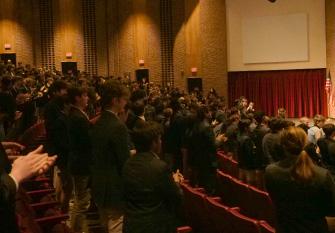
The majority of Reflection-givers are required to give them based on their standing in the Signet Society — a group of peer-elected Sixth Form leaders—and thus, it was only natural that not every speaker would bring the audience to their feet. This common acceptance that not every Reflection was going to be exceptional allowed the community to keep its expectations in check. However, somewhere along the way this year, students unintentionally set a precedent for giving standing ovations to each speaker.
This precedent proved to be dangerous because as the school community gave its all after each Reflection, it expected the same from the speaker. As people continued to stand up, the expectations for each next Reflection grew up to a point that could rarely be met.

So, why can’t we stop? If a Reflection isn’t good, why should it receive the highest praise an audience can give?
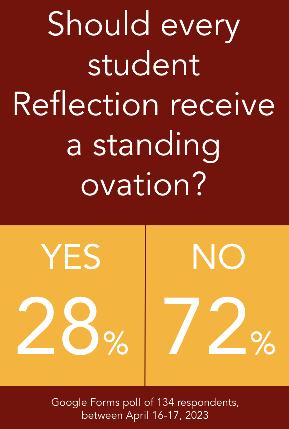
It’s a matter of virtue. When a student or faculty member gets on that stage, no matter how much of an effect their subject has on you, they are still vulnerable.
Even if it isn’t vulnerability directly within the story they are sharing, it’s vulnerability through the act of sharing something that the wider community may not see as important and the silent criticisms that come with that. Even if a Reflection isn’t about the most serious of topics, everybody who gets on that stage deserves to have the audience support them fully.
Bringing up virtue seems like a cop-out answer, I get that. But think back to other instances where we stand up for our peers no matter how they perform.
Take the talent show, for example. During a performance where someone is clearly nervous, we start singing and clapping along, and give everyone a big standing ovation. That’s what support means.
That’s what makes this place unlike any other.
If we don’t stand for one another, then who will?
Nonetheless, there are some considerations to be made for future Reflections. To students, look at Reflections as time to learn something new about someone you may or may not know; let deeper meaning and revelation be a rare but welcome accent to your
time.
To administrators, don’t force students to give a Reflection. It seems that the majority of this year’s problems came not only because of high expectations—something an audience has a right to have—but also because Signet Society members were forced into them.
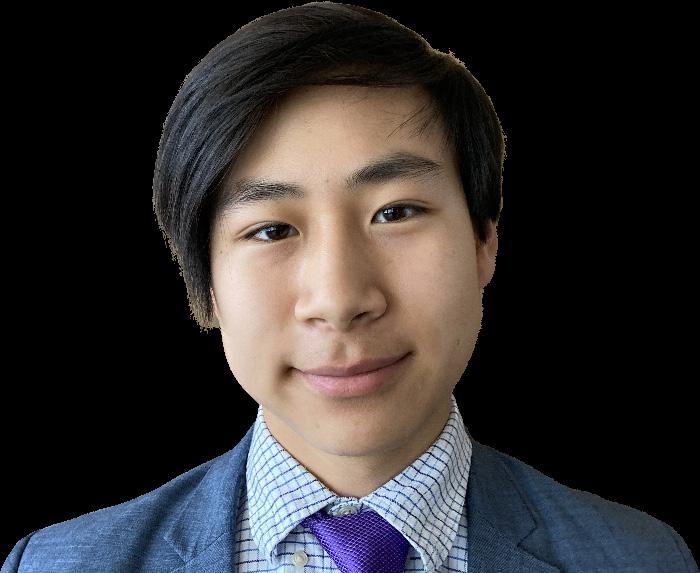
Consider the effect forced Reflections are having on the reputation of what was once a well-respected event, and if quantity must supersede quality.
Finally, to future Reflectors, don’t be afraid to tap into your emotions when you reflect.
Leave no room for regret after getting up on the stage—you’ll only ever remember what you didn’t say.
Easter Monday should be a school holiday
What do you think of first when you hear the word “Easter”?
For some, it may be the Easter Bunny or the resurrection of Jesus Christ. If you’re like me, you immediately think of a long weekend. With the recent passing of Easter, the question of why Monday is not a day off has probably crossed the minds of many.
eggs down hills as a symbolic representation of the rolling away of the stone from Jesus’s tomb. In other countries, it is a day for festive processions, special meals, and other traditional activities.
For Haverford students, Easter Monday is possibly one of the worst days of the year. Going back to school after a three-day weekend is extremely painful. As I witnessed during a first-period Spanish class, people usually come back tired. Having an extra day off could allow for some families to go on vacations, or maybe even just an extra day of rest.
Easter, a significant Christian holiday that celebrates the resurrection of Jesus Christ, is observed by billions of people around the world. Easter Monday has historical and cultural significance, and the tradition of observing it dates back centuries. In some countries, Easter Monday is associated with egg rolling, where children roll
Some may argue that having a day off on Easter Monday would disrupt the school calendar or create challenges in terms of meeting academic requirements. However, planning ahead and adjusting the calendar to accommodate the Easter Monday holiday, just like other holidays—such as Christmas, New Year’s Day, or Thanksgiving—is a small price to pay in return for the day off.
Having Easter Monday off would allow for religious observances, family gatherings and celebrations, and a much-needed break to rest and recharge.
 Luca Aloi ’25
Arsh Aggarwal ’24
Luca Aloi ’25
Arsh Aggarwal ’24
campus opinions the index · campus opinions April 2023 Page 13
Standing ovation after Mr. Tate’s Reflection PIERCE LAVERAN ’24
For Haverford students, Easter Monday is possibly one of the worst days of the year
on Easter Monday INDEX STAFF
Haverford calender showing classes resuming
FORDS @

Eight works of student photography from Haverford’s spring



Page 14-15
Hallgrimskirkja
A
ALI ISLAM ’23
ALI ISLAM ’23 the index
SEAN BRODNIK ’24 Downtown Reykjavik, from the Hallgrimskirkja
Reykjavik street scene
Geese and ducks, downtown Reykjavik
Northern
ÍSLAND

spring trip to Iceland, selected by the Index editorial and faculty.




@
index · arts April 2023
ALEX HERRMAN ’23
Glacial tunnel in South Iceland
JOE PARIANO
CHASE NELSON ’24 Greenhouse vineyard at Friðheimar
’23
MUSAH
ALI ISLAM
Northern lights over Reykjavik
JABATEH ’24 Glacier in South Iceland
’23
Jingyuan Chen

It’s not about who should carry the burden of writing academic comments. It’s about giving students access to valuable perspectives.
Several weeks ago, upper school students toiled through the process of writing self-reflective second-semester comments. Teachers signed off and then released them to MyBackPack in mid-March.
Since March 2022, students, not teachers, write self-reflective comments about their performance in class. Teachers add remarks in response to these self-reflections, but students now possess the power to sethe tone and guide the narratives.
Upperclassmen should still remember: receiving quarter interim comments was a nerve-wracking experience. Much agony and joy accompanied comment release day.
Students should not write semester interim comments, teachers should
Those days are no more. Since March 2022, students, not teachers, write self-reflective comments about their performance in class. Teachers add remarks in response to these self-reflections, but students now possess the power to set the tone and guide the narratives.
The agony. No more. The excitement. No more.
While I was at first a little disappointed at losing a source of external validation, I thought that most students would have liked to see this shift.
They did not.
Ethan Lee ’24 at The Index was the first to report on this shift. In a March 2022 poll with 105 upper school respondents, 84 percent answered “No” to the question “Was the self-reflective process effective for you?”
Yes. People dislike changes—it’s part of the reason why the poll response was overly negative. But it isn’t that simple.
Upper School Head Mr. Mark Fifer responded in Lee’s article, stating that this shift “would bring a more authentic voice to comments” and that the school “tried to give students some more ownership over reflecting on their learning.”
In that same piece, Luke Fesnak ’24 said, “I think my parents and I value the teachers’ opinions a little bit more than mine. I
understand self-reflection is important, but a teacher has something to say that I don’t.”
He is right.
According to The New York Times’ Melinda Moyer, people rarely share constructive criticism, because we underestimate just how much other people want it—“an error we make both at work and in everyday situations.”
Criticism can be helpful, soul-wrenching, or a mix of both. Constructive criticism is rarely given, but it is educationally beneficial.
Criticism can be helpful, soul-wrenching, or a mix of both. Constructive criticism is rarely given, but it is educationally beneficial.
Research posted by the U.S. Department of Education compiled the results from a dozen statistical experiments and concluded that “assessment theories and academics alike espouse the importance of feedback on
performance assessment tasks for supporting improvement and progress in student learning achievement.”
It’s not to say that self-reflections are not of immense value. It’s just that internal and external feedback shouldn’t be confused as one.
It’s not to say that self-reflections are not of immense value. It’s just that internal and external feedback shouldn’t be confused as one.
Instead of providing just another chance for self-reflection, the semester interim comments should remain separate and intact as a part of Haverford’s teacher feedback system.
The mindfulness in jigsaw puzzles
It’s 8 o’clock on a Monday morning, and you walk through the doors of Severinghaus Library. Half awake, still rubbing the sleep out of your eyes, you greet whoever happens to be at the front desk. Thinking of ways to prepare yourself for the coming day, you face a choice: Ms. Stinson’s Mindfulness Club or the jigsaw puzzle, whose pieces are strewn about the countertop of the library’s long counter.
Mindfulness is the act of bringing one’s full attention to a certain activity or object of choice...If you want to be engaged in an activity that requires focus and concentration, yet still moving around, the library jigsaw puzzle might be for you.
Mindfulness is the act of bringing one’s full attention to a certain activity or object of choice. For example, when doing breathwork and meditations, the goal is to bring full attention to the breath. But, if you are someone who cannot sit still and take deep breaths, mindfulness can take a different form. If you want to be engaged in an activity that requires focus and concentration, yet still moving around, the library jigsaw puzzle
might be for you.
While mindfulness and working on a jigsaw puzzle may seem like different activities, they have a similar effect on the mind. Depending on the type of person you are, time can fly by while doing either activity.
While mindfulness and working on a jigsaw puzzle may seem like different activities, they have a similar effect on the mind. Depending on the type of person you are, time can fly by while doing either activity.
When doing puzzles, the brain enters a mindful state and often loses track of time. Often, I’ll look up thinking 30 minutes have gone by, when, in reality, it was two hours. I spend rainy days in the back room of my house, tucked away in a corner of jigsaw puzzles and podcasts.
In addition to their calming effect, doing puzzles releases small doses of dopamine with every match made. This dopamine release can be addictive, driving people to spend all night working on a puzzle.
Studies have shown that while searching for pieces across the table, the process
of making matches strengthens short-term memory. The act of doing puzzles engages both sides of the brain at once.
Puzzles also build spatial awareness by helping the brain understand and learn to fit certain oddly shaped things into a compact shape. When a puzzle comes down to the final act, the only distinguishing features can be the texture of the pice itself along with tiny smidgens of color in its corner or the shape of the actual piece.
Puzzles also build spatial awareness by helping the brain understand and learn to fit certain oddly shaped things into a compact shape.
When a puzzle comes down to the final act, the only distinguishing features can be the texture of the piece itself along with tiny smidgens of color in its corner or the shape of the actual piece.
As Sixth Former Joey Kauffman recently noted in his upper school Reflection, many students feel much pressure to succeed in school.

This pressure can result in high levels of anxiety and depression. Often, students find themselves with little free time and a lack of sleep.
One way to counteract this academic pressure is for students to take time out of their day to do things that make them happy, make them feel relaxed, thereby decreasing anxiety levels.
The next time you see the library puzzle in disarray, pieces strewn all over the table, don’t just walk by. Take a few minutes to put a few pices together.
The next time you see the library puzzle in disarray, pieces strewn all over the table, don’t just walk by. Take a few minutes to put a few pieces together.
Those pieces might not seem like much, but they may turn out to be just the outlet for your academic stress and pressures.
Liam French ’25
the index
campus opinions April 2023 Page 16
’23
·
When handed the graduation project proposal form in advisory, I scanned over the brief directions, focusing on the roughly ten printed lines provided to describe my project. My project idea was ambitious: to write, choreograph, and film a pilot episode of a mockumentary. Now I had to condense the hours of conversations and planning I’d had with my advisor and friends into ten lines?
After a two-month wait, I was more puzzled at the feedback from the graduation project committee: one group member’s proposal was accepted, the other required revision, and the third denied. The comments were brief, “not a graduation project“ and “do you have what it takes?”
Many Sixth Formers find the initial project proposal process constraining. Sixth Former Ronan Wood’s initial proposal, to shoot sports photography at Haverford games, was rejected for being incomplete. However, Wood’s understanding of the initial proposal’s intention was to convey a general idea of what he wanted to do, not necessarily to provide in-depth detail.
“I think it would be fair if I gave a lot of detail and they didn’t like it,” Wood said. “I don’t think you can just turn something down without having the extra detail.”
According to graduation project committee members Mr. Ator and Mr. Lengel,
Graduation project proposal process needs clarity
students are not limited by the space on the initial project form. “You can always turn the page over and write on the back,” Mr. Ator said.
While that may be technically true, administrators running the process never explained this to Sixth Formers. In a school with deliberate rubrics surrounding every paper, it is a stark oversight that there is little instruction on how students should sound out the last three weeks of their high school careers.
We need more clarity on graduation projects’ proposal requirements. Mr. Ator agrees, saying how the idea of only providing “a yes, no, or maybe is the wrong way to go about it, and instead your feedback should be the ten questions I have” in response to reading a proposal.
We should be given more of the faculty’s thoughts and more positive feedback with proposals. From a student’s standpoint, seeing just the red, indicating a rejection, next to my name feels like a definitive “no” before having the chance to fully express myself.
The root of students’ struggle with graduation projects is not in knowing what they want to do but rather in getting help in proposing it, especially for creative projects. Internships are approved easily because the committee knows exactly where a student will be and when they will work. Inversely, creative projects are inherently more difficult
to get approved. Mr. Lengel agreed with my point.
“It is not to say that creative projects are less valuable; that is certainly not the goal. But it is to say that if you’re going to be doing something more self-directed, you need to convince the school of where the time is going,” Mr. Lengel said.
To solve this, we need to move away from judging the schedule and focus more on evaluating the deliverable. Ronan Wood could not provide the exact games and times he would be photographing because the spring sports schedules weren’t released yet, but he could say how many photos he planned to take and where they would be shared.
“I do think there is room to focus way more on the outcome, the deliverable…and I’m in favor of moving towards that” Mr. Lengel said.
Graduation projects are a way for students to give one last push, a time for students to explore themselves. Given the possibility of a proposal being rejected and the time pressures placed on a student whose proposal was rejected (a four-day turnaround time for re-submission), Haverford should adopt a rolling admissions process for graduation projects.
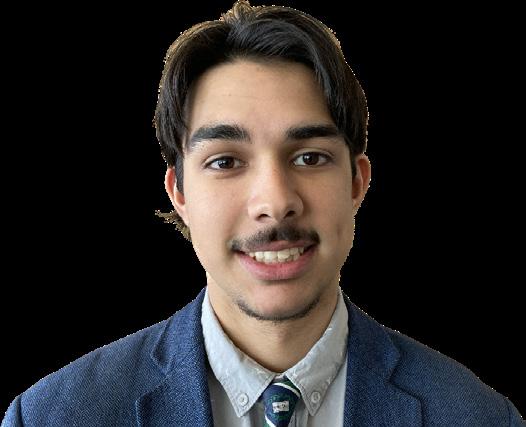
Rather than a flat-out due date, Sixth Formers should have the option of submitting initial proposals early, which would
The 2022-23 Index Staff
enable them to get official feedback and approval/rejection and respond in a more timely fashion.
Wood followed something similar, working closely with Mr. Ator on how exactly to phrase his essay. If a rolling process with continuous and reactive feedback were to be clearly laid out, more students would be confident with their proposals when submitting.
Creative projects should be allowed to focus on the end goal that students hope to achieve to gauge the validity of a project.
In an ample period of time, students should have a more guided and responsive space to workshop their ideas and get official school feedback. From my discussion with graduation-project committee members, it is clear that they care; it is clear that they have thoughts in response to our ideas, but we need a better platform on which to express them.
“There should be more encouragement to go talk with your teacher, to go talk with your advisor…Let’s make this more than just, ‘Hey, seniors, go do this.’ Let’s have this be something you think about a lot earlier,” Mr. Ator said.
I believe graduation projects, with furthered support from faculty and students, can be the proper capstone to all of our Haverford careers.
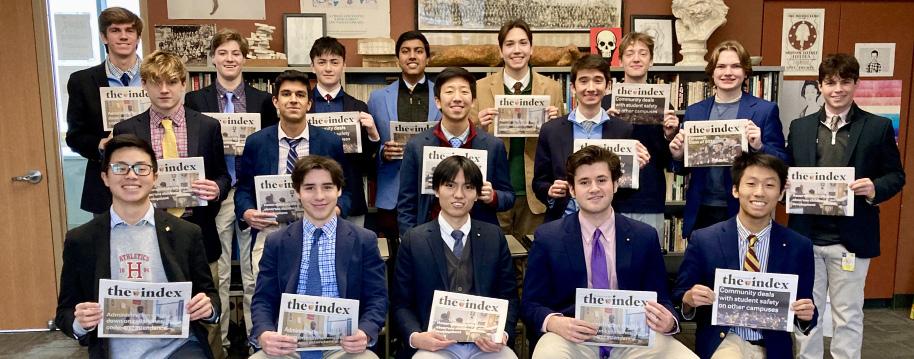
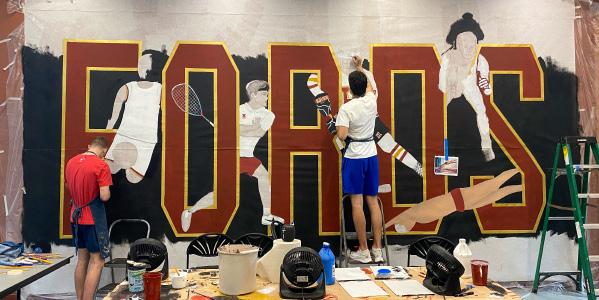 Zach Shah ’23
Zach Shah ’23
the index · campus opinions April 2023 Page 17
Fisher Bond ’22 and Peter Kaplan ’22 work on spring sports’ mural in the Community Room
COMMUNICATIONS
PIERCE LAVERAN ’24
In the United States you become a legal adult at the age 18. You are able to vote, join the military, and be sent to prison, but you are not legally allowed to drink. It is common for young adults to drink while being underage due to the drinking cultures associated with high school and college. Although many young adults participate in this culture, those caught may face harsh punishments that
The drinking age promotes unhealthy alcohol consumption
can have lasting effects on their life.
Laws do not stop anyone from drinking. They just make it more dangerous for young adults.
These laws force young adults to drink in secret, often without parents’ knowledge. They create a dangerous environment because many young adults drink too much and do not go to the hospital to get their stomach pumped because of the fear of the consequences. Many young adults drink hard alcohol because it is easier to hide in something like a backpack.

This causes more people to develop an unhealthy relationship with alcohol because they never learn how to drink properly. Many young adults drink with the goal of getting as drunk as possible. This causes around 5,000 deaths, 600,000 injured, and 100,000 cases of sexual assault.
In Europe, where alcohol consumption is more normalized, teens learn how to drink socially during meals without feeling the need to hide it. Young adults drinking in the open makes it safer and less likely for someone to not get their stomach pumped, even if they need it.

Yes, alcohol can be dangerous, and, yes, drunk driving is bad. But in today’s society there’s no need to drink and drive because of apps like Uber.
The drinking age is 21 because of the
National Minimum Drinking Age Act. This act made states lose federal highway money if they lower the drinking age.

The National Minimum Drinking Age Act was made to stop drunk driving, but it has had the opposite effect. Every day around 32 people die from drunk driving in the U.S. compared to around eighteen a day in Europe.
Europe contains double the population
of the U.S. This means there are far more deaths in the U.S from drunk driving, proving the National Minimum Drinking age act had the opposite intended effect.
As someone with immigrant parents who has been raised with their views and the rest of the world’s view on alcohol and someone who has felt the consequences of being caught, I believe the U.S. needs to change these pointless laws.
Pick one and run with it… but when?: Single-vs. multi-sport athletes
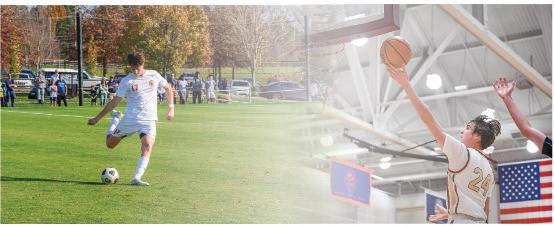
Times change. The top athletes in the world used to strive to perform at the highest level, and those who played several sports received high praise. Looking at most stories of the “greatest athletes of all time,” athletes like Jim Thorpe played multiple sports in high school, some in college, and some even beyond that.
Eighties icons Bo Jackson and Deion Sanders each played two sports at the professional level. Jackson and Sanders have been asked multiple times recently whether they could do what they did in today’s environment. Jackson feels it cannot be done anymore. The best someone who is talented enough can do is “second string at both sports.”
A New York Times article mentions Cardinals quarterback Kyler Murray’s admiration for Jackson, saying “Murray teased the possibility of playing both sports in a photo he posted to Twitter in November, re-enacting a ubiquitous Bo Jackson photo from the 1980s. ” Even though Murray was the first ever taken in the first round for the MLB and NFL drafts, he still only chose to play one sport professionally.

Now, fathers of athletic children mimic LaVar Ball, an infamous father who sent two of his children to the NBA. A Sports Illustrated article says, “LaVar Ball has long said
his dream is to have all three of his sons on the Lakers.” The Ball family received much attention because of the plan LaVar put together for his boys. Ball planned everything from what time they woke up to which classes they took.
Ball’s blueprint seems to be a ticket to success. In 2017, his oldest son Lonzo was drafted second overall to the Los Angeles Lakers, and at one point in 2022 all three sons played in the NBA.
It could be worth taking the risk now
and hope you hit the jackpot. College coaches, including Deion “Coach Prime” Sanders himself (arguably the most-talked-about college coach in the country right now), say they love multisport athletes because it makes them “complete athletes.”
But the recruiting process is set up to make it backbreaking to keep up with multiple sports tournaments and camps.
Kids should stay active 24/7 because children are building up different parts of their body and skills that will help other
sports. A lot of times families get caught up in the false illusion that middle school accolades are important.
Once a child expresses what they love the most, they need to pick going into high school. This is when accolades start to matter.
Only then can you put together a strategic plan to achieve the child’s dream.
The best roadmap is for young people to play as many sports as possible.
Chace Knox ’23
A lower drinking age might discourage binge drinking, like beer pong VIA WIKIMEDIA COMMONS
the index · off-campus opinions April 2023 Page 18
Cameron Douglas ’23
off-campus opinions
COMMUNICATIONS; DESIGN BY ARSH AGGARWAL
Billy Beifeld ’23 (left) prepares to kick a soccer ball; Silas Graham ’27 shooting a layup
‘24
The West viewed Russia’s invasion of Crimea in 2014 as another “incident,” like invading Georgia in 2008 and Chechnya in 1999 and 1994. To the Ukrainians, Russia was making a promise: We will reclaim.
Putin’s war has lost over 1,900 tanks, and nearly 200,000 troops, and currently relies on convicts to patch up massive holes in its infantry battalions. Corruption, incompetence, and miscalculation gutted the Russian military, incapacitating its war goals and allowing Ukraine to free itself and integrate with the West.
Last year, Ukrainian forces liberated almost the entirety of the Kharkiv Oblast and the north bank of the Dnipro River, including Kherson, controlling over half the land stolen during the early stages of the war.
The Ukrainian military extensively planned the offensive with American and British defense officials, helping them determine high-value targets, wargaming the Kherson offensive, and determining whether or not to attempt to retake the Zaporizhzhia Oblast.
After a winter that was supposed to freeze Europe, Ukraine can deliver a knockout blow to Russia.

A recent report from D.C. think tank Institute for the Study of War stated Russia’s winter offensive could culminate without capturing Bakhmut, the linchpin for Ukraine to destroy Russian forces, leaving them susceptible to a Ukrainian counteroffensive.
The counteroffensive will start during the summer and will be the beginning of the
On the importance of winning: we must resupply Ukraine
end. Ukraine will target the land bridge between Russia and Crimea, the only achieved Russian war goal, cutting the peninsula from supply lines and setting the conditions to free the entirety of Ukraine.
Ukraine needs tanks, planes, and, most importantly, artillery shells to go on the offensive. Ukraine estimated that it would need one million rounds this year. The EU is trying to meet demand, but the real problems come from the supply.
The United States plans to ramp up the production and delivery of 155 mm artillery shells to 90,000 per month within two years.
Two years is too long, and Ukraine needs the rounds now to knock Russia out for good.
I am no flag-bearer of military spending. We pay our service members too little, and too much money returns to Washington. However, the United States must guarantee Ukrainian victory.
Built on years of supposed military
victories, Putin cannot survive a defeat that has cost hundreds of thousands of lives. The Russian public has historically shown their distaste for their sons dying needlessly. Winning the war will set up the collapse of the Putin regime.
The United States and NATO must do whatever is necessary to enable the Ukrainians to win. We need more willingness to give and spend from the White House, the Pentagon, and Congress.
What is the “Red Pill”? Should I take it?
Entering the auditorium to watch my high school perform a musical, a girl I had recently met texted me that she was also there watching the show. The auditorium was packed, so my friends and I could barely find a seat, let alone the girl who texted me. Throughout

the musical, I was filled with an underlying anxiety about an awkward interaction with her. This fear pushed me away from talking to her, leading me to leave the musical without ever speaking with her.
This ruined my future chances with her, which I definitely regret. Yet to specific
members of a movement called the “Red Pill,” I did the right thing.
The “Red Pill” is an online community hosted on Reddit, which spews messages of misogyny and prejudice against women.
Men following the MGTOW philosophy seek to separate themselves from what they view as a female-dominant world, mainly by not forming relationships with women.
Because of the internet’s interconnectivity, people with this deluded mindset are able to interact and forge a deep-rooted community, which has spread from small Reddit forums to larger audiences on social media platforms, and high-traffic websites, creating an online network of different “Red Pill” sites called “the manosphere.”
The community’s name, “Red Pill,” is a reference to an iconic question asked by the character Morbius to Neo in the 1999 movie The Matrix: “‘You take the blue pill—the story ends, you wake up in your bed and believe whatever you want to believe. You take the red pill—you stay in Wonderland, and I show you how deep the rabbit hole goes.’”
To this community, the “Red Pill” represents a fundamental truth that governs our society, which when learned allows men to escape the “matrix,” or their societal disadvantage in finding a female partner.
Forged from this idea are the “Red Pill” movement’s most radical and popular groups, including involuntary celibates (incels) and Men Going Their Own Ways (MGTOWs).
The “Manosphere” enables “Red Pill” male groups to separate themselves from the female gender, causing these groups to develop the idea that men and women are wildly different creatures each with their own set of specific roles within society.
Recently, a twenty-two-year-old named Tres Genco, who was found to have formulated a plot to kill women and intended to carry it out.” Genco’s desire to “slaughter women was out of jealousy and revenge,” demonstrating how the manosphere’s extremist views can infect one’s judgment.


Life is brutal, and hiding from that reality does nothing but hamper one’s ability to discover the beauty which lies beyond life’s hardships.
So next time you’re confronted by an awkward situation, embrace it.
Willys Silvers ’23
Kiran mistry ’23
President Biden met with President Zelensky of Ukraine ouside the Mariinskyi Palace in February 2023
the index · off-campus opinions April 2023 Page 19
WIKIMEDIA COMMONS
The audience rises at the Friday, March 10 performance of Les Miserables, one of the few co-educational opportunities for upper schoolers
MR. JERRY MCCRONE
The “Red Pill” represents a fundamental truth that governs our society.
Strolling through the school parking lot in September, I stopped as I noticed four new parking spots painted green. I saw newly installed metal electric car chargers. I thought, “Are these cars really that popular?”

As climate change roars on, more people are talking about electric cars. Electric vehicles could be the future, or it could just be another business with a bright future but not as much traction.
California proposed to have fully electric or hybrid vehicles by 2035. Advocates believe it would reduce the world’s carbon footprint due to lower emissions. Everyone, including myself, wants a healthier earth, but 2035 is only twelve years away.
We’re not ready yet.
Electric cars have grown more popular during inflation this past year. No one wants to see each dollar digit rise with each pump of gas.
Even with all this success, electric cars still are not the full solution to climate change and carbon emissions. A car buyer must be cautious about electric cars due to many unhighlighted environmental impacts.
One major downside is the long term, when lithium batteries degrade. We can not reuse old batteries. Once a battery gets about a few years of usage, it takes over 100 years to decompose.
This is one reason to wait until technology improves to buy an electric car:
Should you buy an electric car?
battery technology is constantly advancing. Manufacturing these batteries raises problems as well.
Some batteries contain large amounts of cobalt, which requires hazardous mining practices. This also occurs with mining lithium, a component of every electric car. These batteries are toxic to the environment, and more batteries create more harm. An increase in electric vehicles would make the U.S. more reliant on other foreign powers. Many parts of lithium batteries require raw materials and manufacturing in other countries.
Most of the countries with these materials are not allies of the United States, such as China and Russia.
A major issue many people have with electric batteries is “radius fear”–the idea of not driving long distances due to worrying about not having a charger nearby. Many countries and even the U.S. might struggle to sustain the mass infrastructure for increased electricity use.

High-voltage chargers are necessary for cars to charge effectively. This can be quite expensive and not available in rural areas.
Electric cars have many potential advantages and future possibilities but need more time to solve many recurring issues that are not always recognized by the common driver.
Personally, I would wait to purchase an electric car.
 Charlie O’Brien ’23
Charlie O’Brien ’23
PIERCE LAVERAN
the index · off-campus opinions April 2023 Page 20
Close-up of a new charger in the Green Lot
’24
Last week while eating at a restaurant I was rudely interrupted by the sounds of a screaming child. It didn’t bother me that much. After all, children sometimes scream over stupid things that parents have no control over.
It’s what the parents did next that bothered me. They sat their screaming child in front of a crusty iPad playing bright colors and loud music. The kid stopped fussing, but something about that troubled me. The whole idea of it just felt dystopian.
Nowadays you can’t go into any public space without seeing some seven-year-old kid with Cheeto dust all over their face holding one of those iPad cases with a handle on it. It’s become such a frequent occurrence there is a name for them used commonly on the internet “iPad kids.”
I can totally understand the need to distract your children, and raising children is challenging. But iPads and other forms of technology-based sensory distractions only damage the child’s development and will impact that child’s psychology for the rest of their lives. A study from the Association for Child and Adolescent Mental Health said screen time was “the heroin of this generation.”
Would you give heroin to a seven year old?
Let’s face it, we are all addicted to technology, but the ones that will be impacted the most by these addictions are the youngest among us.
iPads and iPhones are a great tool for airplanes and long car rides. It’s the constant use enabled by parents that don’t have the
iPad kids, the bane of the next generation
time or energy to entertain their children that damages children. These technologies offer great upsides that many of us can’t live without, but small children do not need these. Besides, I have never seen a kid using an iPad for constructive purposes.
There is a reason Baby Shark has over 12 billion views.
Children today in preschool and elementary school are having trouble socializ-
ing with their peers. Most professionals agree that this disconnect can be attributed to the fact that most kids’ dopamine comes from a screen. When children are bored, they are forced to do something new, meet a new person, push themselves out of their comfort zone. But with the constant option of plopping your child in front of a screen anywhere you go, kids never have to be bored.
The modern phenomenon of the “iPad kid” is almost brand new. We still don’t know the effects of high technology doses on adolescents, let alone small children. Every parent should know the dangers of technology based stimulation and how they can affect their children in the future.

Next time your kid is fussing, just give them a coloring book.
The death of competitive sports leagues?
“There are rich teams and there are poor teams. Then there’s 50 feet of crap, and then there’s us,” Oakland A’s general manager Billy Bean said.
Major League Baseball is one of, if not, the biggest sports league in America, but it is also the most flawed. The New York Mets
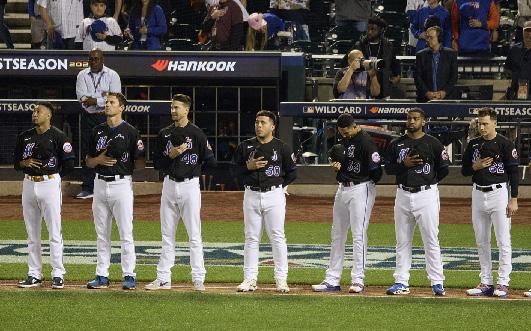
currently have the highest payroll in baseball at $336 million. The lowest team payroll is the Oakland Athletics at $40 million. Clearly, the MLB does not have a salary cap, which is incredibly unfair.
According to an article in The New York Times, “teams have announced that their economic plight is so serious that they face
the possibility of going out of business.” Without a cap, large-market teams with deep pockets outprice smaller markets when acquiring players, ultimately creating an unbalanced, skewed league.
with the overall team salary lands them at about $401 million allocated to the team.
The Spurs are $22 million under the set salary cap this year. For those matchups you have a team with a total cap of $401 million against a team constructed of $101 million.
Incredibly flawed right?
The league intends the luxury tax to discourage teams from spending too much money on player salaries and to promote competitive balance in the league. However, the current system has unintended consequences that have created additional problems, such as discouraging teams from investing in their rosters and creating a disincentive for small-market teams to compete.

Creating a salary cap would produce financial stability for players while promoting movement to smaller markets, generating more fan interest in struggling economic situations.

Switching leagues, the National Basketball Association’s salary cap is set at $123 million for the 2022-2023 season. The Golden State Warriors have a total team salary of $190 million, and are set to rise to $211 million next season.
The Warriors are currently paying $280 million into the luxury tax, which combined
The current system is ruining the sports we love. Instead of implementing the pitch clock, actually make changes that need to be done.
Yes, there is an argument that larger markets should not be punished for having more economic wealth and fan interest. It can also be said there should be no punishment for retaining talent through the luxury tax.
Those can be compelling arguments, but if there is no salary cap implemented in baseball or if the luxury tax is not fixed, it could be the death of competitive sports leagues.
Nicholas Keszeli ’23
Zach Elder ’23
VIA WIKIMEDIA COMMONS the index · off-campus opinions April 2023 Page 21 New York Mets pregame lineup, Oct 7, 2022 WIKIMEDIA COMMONS
Children playing a game on an iPad
Without a cap, largemarket teams with deep pockets outprice smaller markets when acquiring players, ultimately creating an unbalanced, skewed league.
Upper school production team members support middle school’s Shrek the Musical, Jr.
Shrek has become quite familiar in popular culture since the film’s original 2001 release. Everyone has come to know and love the movie for its outlandish characters and fairytale-based storyline.
After performing Addams Family last year, the middle school theater department will perform Shrek The Musical, Jr. For director Ms. Jennifer Hallman, it felt like the obvious choice.
“For years, the boys have been begging me to do Shrek, and I knew we needed some joy after being shut down for so long. Last year was fun to be back, but we were still rebuilding,” Ms. Hallman said. “I thought this would be the perfect way to get as many kids as possible involved.”
And it clearly worked. This year’s show has 56 students involved, while last year’s had 26.
Some upper school students have also been involved in the production, like Fifth Former Jai Bonaparte, who was heavily involved in the high school’s March production of Les Misérables as the Head of Wardrobe.
“Since Les Mis wrapped, I’ve been helping out with Shrek as a wardrobe assistant. Pulling and organizing costume pieces, helping out with fittings, nothing major,” Bonaparte said. “Typically work behind the scenes of middle school shows is more relaxed than the high school productions, and thus far, my experience has been nothing but positive.”
Bonaparte has much creative freedom.
“Ms. Hallman has been incredibly gracious with me, letting me design and construct the costume for leading lady Princess
Fiona. Angie Fontana, the talented actress portraying the role, has been wonderful to work with,” Bonaparte said. “Seeing projects like this go from initial concept to design to the final product is one of my favorite parts of theater, and I’m incredibly grateful for the opportunity.”
Other upper school students have joined the show’s stage crew in lighting, set design, and more. Fifth Former Samuel Jiru has been a part of designing and painting the set.
“My favorite part of the show has been being able to, for the most part, be completely unrestricted. I’ve been able to almost entirely design it with Jai’s help, with almost no help from the adults. It’s just been us working on it,” Jiru said.
Ms. Hallman said, “I am most looking
forward to seeing the eighth grade guys this year step fully into the principal characters. They have worked so hard, and as sixth graders they didn’t have an experience like this at all, so last year was their first show with me. Now having them play specifically Shrek and Lord Farquad, it’s next level. They have grown so much. Everything the boys do in middle school helps them work their way up into being more confident onstage and earning those big roles, and I’m lucky enough to see them through high school too.”
Ms. Hallman also stresses the importance of the high schoolers coming to see the middle school show, especially those who have participated in past Haverford productions.
“The middle school kids look up to the older boys so much,” Ms. Hallman said.
“There were so many of them in the audience at Les Mis, and there were so many of them in the audience last year as well. They just love what the boys do and they want to be like them, and I think seeing the older kids in the audience will make them the happiest kids on the planet.”
Shrek, Jr. runs in Centennial Hall on April 28-29 at 7 p.m., and April 30 at 2 p.m.

Bonaparte is excited to see the final product. He says that the high school students should see the show, “Because it’s a great time! All of the actors involved are oozing with talent and have an undisputed passion for what they do. They’ve been working at this show tirelessly since January and are just about ready to pop with excitement! The show is hysterical and tickets are cheap, there’s no reason you shouldn’t come see it.”
Just glad to be “Part of It”: Jordan Davis’ Bluebird Days
Dogs, beer, and heartbreak are the stereotypical cornerstones of every country album, but Jordan Davis focuses on more meaningful ideas.
Releasing his first studio album Home State in 2018, Davis has quickly ascended to country stardom. His 2023 album Bluebird Days tells a story of cherishing what you have while you have it because there are more important things in life than material objects.
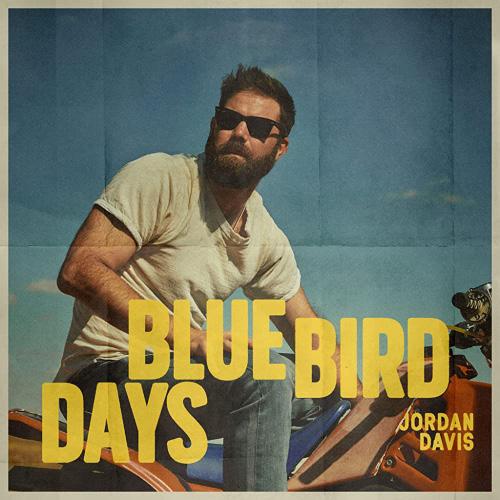
The songs that stand out are “Part of It,” “Buy Dirt,” and “What My World Spins Around.” All three songs are unique but share the same central theme: living in the moment.
It is safe to say that Davis’s album is part of the new wave of country music. While the basic ideas of the genre remain, how the artist portrays the ideas is different. The melody and instruments in Bluebird Days fit this narrative.
The album contains the cornerstone guitar rhythm in a typical country music song with a slight twist due to pop music influence.
This isn’t your parents’ country music.
In “Part of It” Davis sings about crucial moments in his life. From his first heartbreak, the death of his grandfather, and the birth of his two kids, Davis learns from these moments and becomes a better person.
Davis sings, “And when you lay it all out and get down to the heart of it,/Man, that’s just life and that’s all part of it.”
Davis says that everything happens for a reason. Every moment, good or bad, means
something.
“Buy Dirt,” with contributions from country music star Luke Bryan, peaked at number 22 on Billboard’s Hot 100.
The song expresses that happiness simply can’t be bought. Davis sings from the point of view of listening to advice from an 80-year-old man saying, “‘Cause the truth about it is/It all goes by real quick/You can’t
high school seniors the most. In a blink of an eye, the first day of class is over, and you are standing on the graduation stage getting
your diploma. Bluebird Days remind us to take life slowly. Be glad to be “part of it.”
buy happiness/But you can buy dirt.”
In a society where money is prioritized, it is refreshing to hear music that preaches happiness over materialism.
“What My World Spins Around” pulls at the listener’s heartstrings, as it is a love song that pulls on your emotions. Lyrics such as “I can’t imagine me living without this/Back forty view on our piece of ground/Watching you watch the sun going down/That’s what my world spins around” show that living in the moment with people you love is a lifechanging experience. Davis sings about prioritizing people over experiences.
Bluebird Days is what every person, specifically high school seniors, should listen to. The theme of life moving fast resonates with
Russell Yoh ’24
Shrek the Musical debuted on Broadway in 2008
Matt Pante ’23
MCA
DREAMWORKS arts the index · arts April 2023 Page 22
Bluebird Days, Davis’ second album in five years, was released on Feb. 17, 2023
NASHVILLE
Bluebird Days is what every person, specifically high school seniors, should listen to.
Ethel Cain: Preacher’s Daughter, Act 1
If you journey through the Bible Belt to Florida, you might encounter Perry, a town located in Taylor County. In the rural panhandle a track and field is merely concrete and gravel poured in an oval shape over a grass plane. This is where Hayden Anhedönia, the mastermind behind Ethel Cain, grew up. Raised in the Southern Baptist church, Ethel lived her whole life believing she was a sin. After coming out as gay to her family, she left the church at sixteen years old. But her church-deacon father had brought her to the church choir when she was a young child, sparking a love of music.
For better or for worse, without the church, the story of Ethel Cain would never be told.
Ethel Cain, Anhedönia’s stage name, first appeared to her one night while working on music. In a Vogue article, she says that she “found herself possessed by a woman named Ethel Cain.”
Thus, Ethel Cain was born. Her story album Preacher’s Daughter was a four-year project. Between 2018 and 2022, Cain released music as a form of world-building for the character Ethel Cain.
track “Family Tree (Intro).” The distorted voice of her father leading a church service is the first sound on the album. The lyrics proceeding are the exposition to set the story: “Jesus can always reject his father/ But He cannot escape his mother’s blood.”
Religious trauma is the album’s main theme. It drives Cain to escape the town she grew up in and abandon her church responsibilities. The mortality of her mother’s blood will eventually wash away, but the divinity of her father will stick with her till death.

Track two, “American Teenager,” is the most upbeat song on the album, despite its depressing lyrics. In an interview with Pitchfork, Cain expressed how “American Teenager” is an ode to the frustration that every
The setting is Shady Grove in rural Alabama, in 1991, a decade after the death of her father, Rev. Joseph Cain, the titular town preacher. The story begins with the intro
teenager feels when they are told that they are the ones who can change the world. In reality, they can’t, because the circumstances given to them at birth have predetermined their fate.
“The neighbor’s brother came home in a box/ But he wanted to go/ Maybe it was his fault.” Not only serving as an anti-war anthem, this song carries out the message stated in the intro that she cannot escape her mother’s blood, bound to become just another pile of ashes resting above, or inside a fireplace. “Say what you want, but say it like you mean it/ With your fists for once/ A long cold war/ with your kids at the front.”
Comparing the kids America sent off to die on the battlefield to the kids who suffer
abuse from their parents highlights another of the album’s themes: intergenerational trauma. “Jesus, if you’re listening, let me handle my liquor/And Jesus, if you’re there, why do I feel so alone in this room with you?” Whether the abuse comes from the hands of drunk parents or the church itself, it is essential to the cycles of despair that prevent American teenagers from going off and actually making something of themselves.
The pillar Preacher’s Daughter was composed around is track three, “A House In Nebraska.” Originally created and composed on GarageBand, Ethel Cain fell in love with a piano sample she found while browsing through sounds for the Preacher’s Daughter project. While sitting on her bedroom floor in Florida, she had the entire song figured out.
“The song just wrote itself in, like, 20 minutes,” she told W Magazine. It is a ballad of past lives and past lovers. “I saw Nebraska as the center of America…It was this empty place that I would imagine myself running away to someday, being completely alone with the love of my life forever. It’s heaven on earth—you’ll never be bothered again.”
that highlights the fact that after their relationship has ended, Cain can still hear the beat of his heart even though it stopped beating for her.
As the story progresses, Cain falls in love with an abusive partner in the song “Western Nights.” She first meets him in the parking lot of a bar on his Harley Davidson. The two indulge in dangerous activities such as robbing ATMs and getting into fights. “I watched him show his love through shades of black and blue…/ The neighbors beat on the walls while I’m face down in the bed.” The love that she has for him is tainted. As she suffers from an abusive partner, she begins to isolate herself from everyone. “I’d hold the gun if you asked me to/ But if you love me like you say you do /Would you ask me to?”
Still desperately trying to attach herself to anything but the church, she is willing to go to the end of the line for him.
Cain and her boyfriend drive across state lines on a road trip to a chapel to get married. Previously, in “Family Tree (Intro)” the lyrics read “Swinging by my neck from the family tree.” Now, a more experienced Cain sings “Take the noose, off wrap it tight around my hand.” In “Family Tree,” Cain starts to take control of her fate. She has abandoned her home town to live a hedonistic, criminal life with her now-husband. In a bank robbery gone wrong, her lover is killed and she is left to grieve his death alone.
Cain expresses her desire to run away from her life in Alabama, back to the house in Nebraska where she would sleep on a dirty mattress on the second floor of a wood cabin. “Where you told me that even if we died tonight, that I’d die yours/ (So I died there under you every night, all night).” She longs for her past lover, reminiscing the nights she spent as “his.” Furthermore, the use of the words “died” and “under you” implies breaking of religious beliefs about virginity and purity. “A House In Nebraska” ends with an instrumental turmoil of muddled piano and guitar chords and a heavy reverb. The emotional turmoil expressed through the hot and heavy guitar and piano sound is a portrayal of heartbreak and unrequited love. Furthermore, the use of reverb is a sonic metaphor
“Let Christ forgive these bones I’ve been hiding/And the bones I’m about to leave.” Here, she confesses to Jeasus Christ and God that she has sinned, but she does not feel any remorse at all. The bones she will soon be hiding are the body and crimes of her deceased husband.
Like Hayden Anhedönia, the character Ethel Cain is a trans woman. This personal line reveals her struggle with gender dysphoria and talks about having to hide her bones—her anatomical structure—from her lover, father, and the church.

The finale of Act One, “Hard Times,” is a song of reflection. Cain sings a song of her childhood. She tells of a child who loved her father in spite of the ways he loved her. “Hide me there/Under the leaves.” Hidden under a bush or in her bed, her father would molest her.
con’t on next page
DAUGHTERS OF CAIN MATTHEW TOMASI VIA WIKIMEDIA COMMONS
Liam French ’25
“The song just wrote itself in, like, 20 minutes.”
ETHEL CAIN
Still desperately trying to attach herself to anything but the church, she is willing to go to the end of the line for him.
the index · arts April 2023 Page 23
Preacher’s Daughter, the debut studio album by Ethel Cain, was released on May 12, 2022
magazine
Ethel Cain shot for W
Religious trauma is the album’s main theme. It drives Cain to escape the town she grew up in and abandon her church responsibilities.
The line “Nine, going on eighteen/Lay it on me” shows the ways in which she was forced to grow up at such a young age. At nine years old, she had to bear the weight of the abuse her father put her through.
“Tell me a story/About how it ends/
Where you’re still the good guy/ I’ll make pretend.” The telling of stories interpolates the way that Ethel Cain might have asked her father to tell her a story before bed. Additionally, this signifies how in most cases of child sexual abuse (CSA), the victim is often too young to understand why that instance just happened and as a trauma response, they put their faith in make believe. “Cause I hate this story/Where happiness ends/And dies with you.” Her childhood died alongside her father. A father who is supposed to provide joy for their child has instead taken the joy out of his daughter’s childhood. Cain is left with a shell of a childhood, filled with the stories of how great a preacher her father was, and all the good that he had brought the community. If she were to speak up about
what her father had done to her, chances are nobody would believe her, as it is psychologically hard to believe that a person you look up to and trust was capable of committing such sin. Worse, she would be ostracized by the community for blaspheming her father’s name.
“On my birthday/ You watched me/ Dancing right there in the grass/ I was too young to notice/ That some types of love could be bad.” As the song continues, Cain sings about her birthday where instead of looking on to her in love and affection, her father preys upon her, watching her with lust. This childhood trauma brings to light the pattern of sexual assault at the hands of the church that plague the nation’s youth. When one preaches Leviticus 20:13, yet goes
Money Heist: who are the real criminals?
Money Heist (originally titled La Casa de Papel) is a crime drama series created by Álex Pina. The show premiered in Spain in 2017, but it gained worldwide popularity after its release on Netflix in 2018. The series follows a group of skilled robbers, led by a mastermind known as “The Professor,” who craft and execute a meticulously planned heist on the Royal Mint of Spain. The show is wellknown for its intriguing plot, well-developed characters, and unique storytelling style.
In the opening season, the Professor hires eight criminals, each with a unique skill set, to pull off the heist of the century. In order to conceal their genuine identities, each team member is assigned a code name based on a city: Tokyo, Nairobi, Rio, Moscow, Berlin, Denver, Helsinki, and Oslo.
The robbery’s planning and execution, as well as the relationships and disputes amongst the characters, comprise the first season’s main themes. The narrative structure switches back and forth between the current heist’s events and flashbacks to its pre-heist preparation. This approach makes the plot more complex and keeps the audience engaged.
century.
Another riveting feature of Money Heist is its beautiful cinematography and art direction, which further enhance its aesthetic appeal. The film depicts intricate details of Spain’s Royal Mint, and the robbers’ clothes and masks are both fashionable and men-
acing. The show’s music is also prominent, with a catchy opening theme that establishes the mood for the whole season. The Italian folk song “Bella Ciao,” a powerful symbol of protest, makes its way into nearly every episode.
The only possible drawback is that
home and rapes their son, the child is left to cary their father’s sin with them their whole life. This is what drove Ethel Cain to escape the church, escape her rural community in Alabama, and find a man who would treat her with the love and care she was denied by her father. Yet intergenerational trauma repeated itself through Cain’s abusive relationship with her husband. Trauma only breeds trauma, as someone who never learned what a healthy relationship looks like isn’t able to see the signs of an abusive relationship.
As Pitchfork puts it: “Ethel Cain’s Preacher’s Daughter encapsulates roiling gloom and smoldering Americana.”
This album is the culmination of all the things you were never taught about on the road to the American Dream.
the show occasionally moves a little slowly, which may not be to everyone’s taste. Still, Money Heist is absolutely worth your time if you love a solid crime drama story with lots of twists and turns.
It will have you rooting for the robbers until the very end.
The Professor has several justifications for pulling off this daring crime. First of all, he thinks that the Spanish government is harsh and corrupt and that the heist will act as a symbol of opposition to the system—a resistance. Second, the Professor believes that the robbery offers an opportunity to highlight the weaknesses of the financial system and the ways in which people in positions of authority can manufacture and manipulate money. The Professor is also driven by a feeling of justice and redemption for himself and his family, whom he believes have suffered injustice at the hands of the system. The Professor’s motivations are complicated but rely on a deep-seated desire to disrupt the status quo.
Well-developed characters are one of Money Heist’s most fascinating features. Each team member has a distinctive personality and background, and each of their personal conflicts and motivations adds to the drama and suspense. The relationship between Tokyo and Rio, a major focus of the first season, is one area where character development is most noticeable. The pair find an unexpected and forbidden romantic relationship while engaged in the biggest heist of the 21st

Cain, con’t from previous page
NETFLIX
Money Heist was first released on Antena 3 in Spain in 2017
Ivan Harlamov ’23
the index · arts April 2023 Page 24
Well-developed characters are one of Money Heist’s most fascinating features. Each team member has a distinctive personality and background.
Someone who never learned what a healthy relationship looks like isn’t able to see the signs of an abusive relationship.
See you in the Blue: Love Death, and Robots’ “Zima Blue” episode
Willys silvers ’23
As I continue to grow older and gain new responsibilities, I find myself longing for the freedom of child-like ignorance. The simplicity of viewing the world through a single, narrow lens removes the burden of understanding our insignificance within the universe. It allows us to dream, to immerse ourselves in the possibilities of what the world could be.
For me, Love, Death, and Robots’ tenth episode, “Zima Blue,” with its breathtaking visuals and its striking, elongated characters, penetrated deep into my consciousness. It sparked a reflection on my past. The episode left me with a feeling of emptiness, as I was reminded that our lives slip away as fast as it takes us to finally find our footing.

to the first journalist who interviews him in over a century, “[M]y search for truth has led me here to what will be my final piece.”
In this “piece,” Zima devolves from his highly complex AI body into the simple robot who used to clean the blue tiles of a young engineer’s pool.
We may never finish a theory of everything—so why keep trying, instead of enjoying the simplicity of our daily lives?
There’s beauty in the universe’s complexity that we can only marvel at. This beauty is depicted through Robert Valley’s direction and animation in addition to Philip Gelatt and Tim Miller’s adaptation of Alistair Reynolds’ short story.
We may never finish a theory of everything—so why keep trying, instead of enjoying the simplicity of our daily lives?
Zima, “Zima Blue’s” main character, is an AI who slowly grew from a simple pooltile cleaner robot into a successful artist who travels the universe to illustrate its fundamental truth and beauty through art. During his journey, Zima finds the universe itself is art, which cannot be effectively portrayed by Zima’s work.
The universe exceeds anything Zima could possibly create, and through realizing that, Zima finds meaning in the simplicity of his robotic youth, where to him the universe was nothing but small blue—Zima Blue— pool tiles for him to clean. Thus as Zima says
It’s almost ironic: in a quest to discover the meaning hidden underneath the fabric of our universe, Zima finds nothing but the meaning in how we look at it. There is a level of beauty in rigid simplicity, which we commonly overlook in our quest to grow.
The story of Zima is not just a story of AI—it’s a story of humans. As we’ve progressed into the information age, we humans haven’t changed. We still find joy in the simple moments of daily life.
Even while trapped in a dark cave of hardships, or nestled in a thorny bush of pain, it’s our job to enjoy our life, because the universe couldn’t care less if we do.
Influencing the influencers: Casiopea and T-SQUARE
Luke weinstein ’23
Everyone is influenced by someone. Whether it’s a student learning the fundamentals from an adept teacher, a teacher stepping up their game under the tutelage of a master, or any other small step along the way, there’s always something to learn from someone else.
Right?
Well what about those above the masters? The legendary figures bestowed with inhuman talents, or the paragons whose skills, abilities, and knowledge eclipse that of even the experts, prodigies, and champions? Every craft has them: Lebron James, Albert Einstein, William Shakespeare. Where do they
turn to when they need an influence?
Enter Casiopea and T-SQUARE.
Both formed in 1976, the names Casiopea and T-SQUARE may not ring a bell, but their music just might. Unbeknownst to even well-versed audiophiles, Casiopea and T-SQUARE continue to be two of the most influential bands in modern musical history, directly inspiring the likes of Nobuo Uematsu, Koji Kondo, and Hiroshi Kawaguchi, the musical composers behind some of the largest video game franchises of all time. If you grew up playing games like Mario, Final Fantasy, The Legend of Zelda, Sonic the Hedgehog, Gran Turismo, Street Fighter, or
any other Japanese game developed during the 80s or 90s, you’ve undoubtedly heard the influences of Casiopea and T-SQUARE.
In 2003, Casiopea and T-SQUARE came together for a day to perform a live concert titled “Casiopea vs T-SQUARE.”
Featuring two electric guitars, two electric keyboards, two drum sets, two electric basses, one piano, and one saxophone, Cassiopeia and T-SQUARE played as one band, rotating between songs from each other’s discography.
After nearly three hours of non-stop jamming, Casiopea and T-SQUARE started their two final songs. The first minutes con-
sists of the soulful T-SQUARE song “Japanese Soul Brothers,” with Takeshi Itoh and Hirotaka Izumi taking the spotlight. Itoh, on the Saxophone, and Izumi, on the piano, go back and forth, Itoh playing a more upbeat section while Izumi changes the pace to a slower tempo. However, at around the two minute mark, Casiopea and T-SQUARE explosively transition to their next song, “Fightman.” It has a more fast paced feel than the previous song—now everyone’s getting their chance to improvise and show off their chops. From now until the end of the performance, it’s a field day for the incredibly skilled musicians.
It starts off with bass players Yoshihiro Naruse of Casiopea and Mitsuru Sutoh of T-Square competing on the stage four bars at a time. Improvisation after improvisation, Suto and Naruse battle to and fro, showing off their dexterity and expertise.
Occasionally during the improvisational sections, they quote well-known songs and artists like “Fascinating Rhythm,” “Smoke on the Water,” pianist Richard Tee, and Mozart’s “Sonata Facile.” Despite being great musicians, they are more than capable of integrating other artists and songs into their own playing, showing that they are open to taking inspiration from everywhere.
Usually we think that when you become the best, you hit a ceiling and there’s nowhere else to go, but what can we take away from T-SQUARE’s and Casiopeia’s performance? Becoming the best is also about learning to take inspiration from everyone, no matter their skill level or their genre.
Even when you’re at the top, there’s always more to learn.
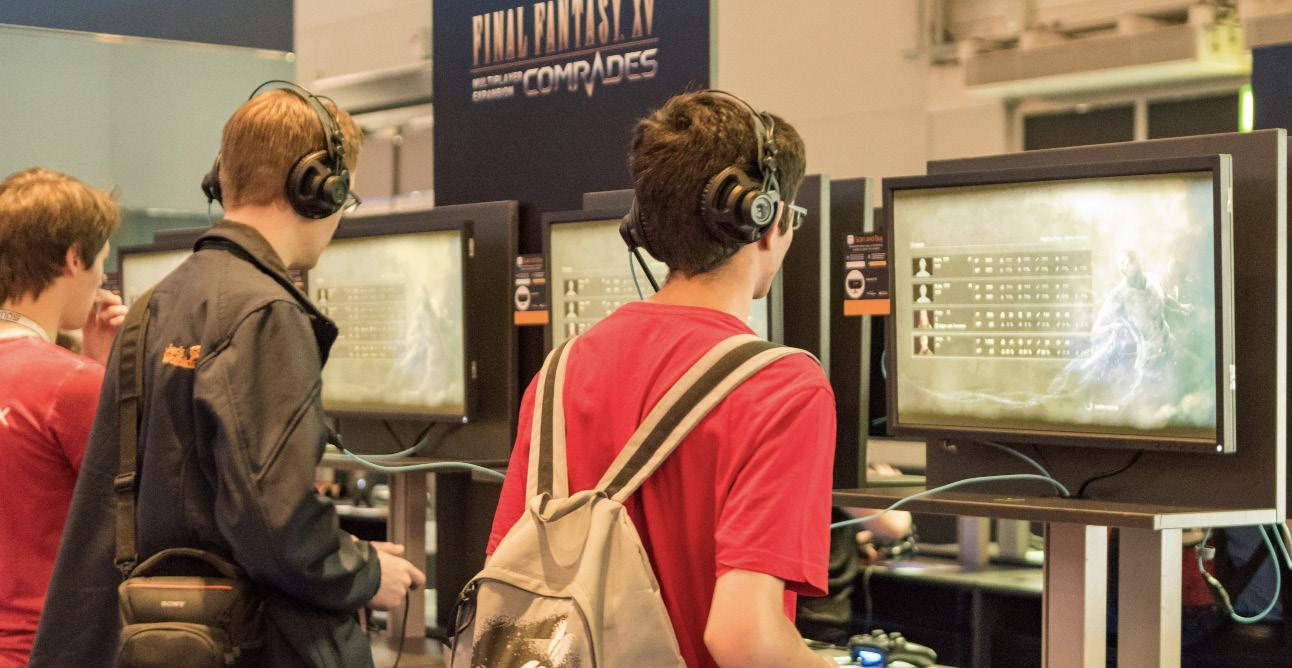 Love, Death, and Robots premiered in 2019
Love, Death, and Robots premiered in 2019
the index · arts April 2023 Page 25 NETFLIX
Members of Casiopea and T-SQUARE inspired the composers of game soundtracks like Final Fantasy
WIKIMEDIA
...to him the universe was nothing but small blue—Zima Blue.
Tennis pushes for thirteenth Inter-Ac title
With twelve consecutive InterAc titles, the tennis team has thrived throughout recent years. Its rich history has been spearheaded by the team’s everlasting dedication and former tennis coach Mr. Antonio Fink’s guidance. Now, armed with a fresh roster and a new head coach, the tennis team eyes another successful season.
At the helm of this year’s tennis team is Coach Zach Lieb, a Haverford ’15 and Penn State ’19 alum. Having gone through Haverford tennis and having coached tennis for many years, Coach Lieb brings an experienced and familiar perspective to the team. Above all, he recognizes Coach Fink’s incredible legacy and contribution to the program.
“I want to give a special shoutout to Antonio Fink,” Coach Lieb said. “He’s done such a great job over the last fifteen, twenty years in really setting a standard and a culture, and creating this reputation of Haverford tennis being one of the top tennis programs in the Northeast and even the country.”
With the team’s foundations already at a high level, Coach Lieb seeks to enhance the
team’s abilities and individual skills.
“My job this year is to really build on what Coach Fink and all these other contributors of the men’s varsity tennis team at Haverford have done over the years,” Coach Lieb said.
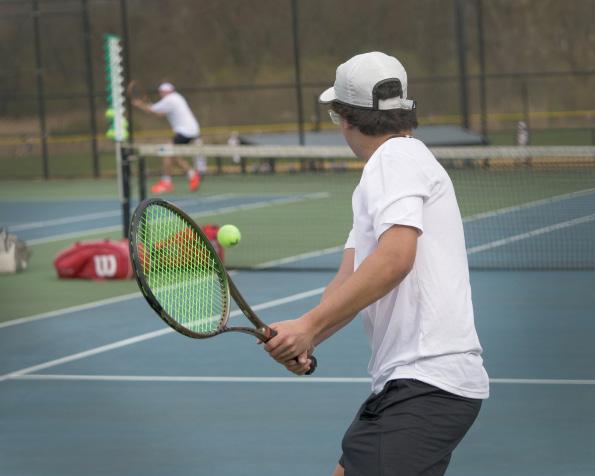

Since the beginning of the season, Coach Lieb has worked on cultivating a rich team culture, especially because of the individual pressure of playing a tennis match.
“What I’ve tried to instill this year is just buying into the tennis family and the team aspect of being on the varsity tennis team,” Coach Lieb said. “Tennis is such an individual sport, and for a lot of people on the team, they play outside of school as well as in school. Tennis can definitely feel lonely sometimes and feel like you’re on an island, but that’s why I think high school tennis and college tennis are so unique: you’re finally out there with teammates and doing something that’s kind of bigger than yourself.”
The Sixth Form players have particularly stepped up and played a tremendous part in making the program feel more teamoriented.
“We’ve got a great core of senior leaders, and then we have some new faces,” Coach
Lieb said. “Every team is different, and it’s kind of finding that right balance between underclassmen and upperclassmen. Something that we’ve really prioritized is the camaraderie and the smaller details and being professional, whether that be on the tennis court but more importantly in the classroom and kind of doing it ‘the Haverford way.’”
And, of course, “the Haverford way” naturally correlates to hard-fought matches and earned victories. This year is no exception. Although different from Coach Fink’s coaching style, Coach Lieb’s approach to
matches, earning themselves a 5-0 record as of April 13, the team is now working on improving their weak areas.
“We’ve had a few matches these past few weeks, and I finally saw the boys in action which was great, but it’s something to build on,” Coach Lieb said. “There were definitely things we felt as a team we could do better in, but there were things that we really felt comfortable in and were really proud of.”
Nonetheless, the team is developing and has found success in their individual techniques and match strategies.
“We had implemented some of these strategies and double formations that we’ve worked on these past few weeks, and we found some early success with that,” Coach Lieb said.
Crowther agrees with Coach Lieb’s observations, and he underscores that it is the team’s ubiquitous support that has helped the team win.
coaching has been effective.
“There’s been a culture shift. I think Coach Lieb tries to guide the team in a different way,” Sixth Form Captain Jay Crowther said. “What I like is that he’s very understanding of each player’s individual game. He obviously tries to build skills across the team that are important for every player, but he also cares more specifically about each player’s individual games and playstyles.”
Coach Lieb’s focus on each individual player stems from his belief that every player is a significant contributor to the team.
“Eleven guys start on the team, but we have twenty-one on the roster. And I’m a true believer that every single player—one through twenty-one—has to always work as hard as they can in practice,” Coach Lieb said. “Each member of our team is there for a reason and brings something unique to the table and equally contributes to the success of our team.”
Having already competed in several
“I think everyone’s finding their place on the team. I think every player has sort of a unique role, but I think everybody works and meshes together well,” Crowther said. “I think there’s a lot of support across the team. At the first game [against Penn Charter], seeing everyone really intensely supporting each other through the blowouts and the tougher matches was really good to see.”
Ultimately, it is the combination of the underclassmen and upperclassmen that enables the team to succeed. As the Sixth Formers cultivate a positive environment, the younger players bring intensity and talent.
“I think the future for this team is bright. We have a lot of deep talent, and I think most of the talent is not in the form of some of the older guys—I think it’s in the freshmen and sophomores,” Crowther said. “There’s a lot of potential to continue to succeed for this team.”
As they enter the heat of the season, Crowther is confident about the team’s future.
“I am very excited. I think everybody is coming together at the right time,” Crowther said. “This first match was a big eye-opener: we’re all in it together, and we
Arnav Sardesai ’23 hits a volley in a match vs Penn Charter, April 4, 2023
MR. JIM ROESE
sports the index · sports April 2023 Page 26
Owen Yu ’23
Jay Crowther ’23 hits a backhand against GA, April 11, 2023
PIERCE LAVERAN ’24
“I think everyone’s finding their place on the team. I think every player has sort of a unique role, but I think everybody works and meshes together well.”
JAY CROWTHER ’23
For Fords Frizz, that’s just the way it is
Joey Kauffman ’23
The ultimate frisbee team, known colloquially as Fords Frizz, does not get the most support from the school. The team does not have varsity status, meaning frizz players cannot get the Iron Man award, given to athletes who participate in varsity sports all through the upper school.
And the student body, known to fervently support most teams in an organized, coordinated fashion, is rarely found at Frizz games.
“Especially at Haverford, no one goes to frisbee games,” Sixth Form captain Matthew Franz said. “I want people to get more excited about frisbee.”
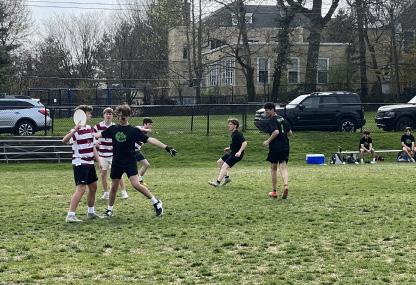
Frisbee, which needs little equipment other than a disc and a field, just lacks the glamor of some other, more high-octane sports.
“If I’m being honest, most [frisbee] kids are kids who quit crew and need a sports credit or quit some other sport or they just need a sports credit,” Sixth Former Ebaad Khan said.
Coming off of three losses against Haverford High School, Shipley, and Abington Friends, Fords Frizz is aware that they are far from the athletically dominant image that the school is known for.
“We don’t have that many players, and nobody’s really too passionate about the sport,” Franz said.
The thing is, they don’t care about everything that is stacked against them.
They don’t care that they’re not perfect,
that the school doesn’t support them, that many of the players are still learning the rules of the game. They just do their thing.
“We always look forward,” Khan said.
To foster this attitude, the team embraces the idea of “short-term memory.”
“Practice is the time we remember, per se. But come game time, short-term memory. Next play, next play, next play. Don’t worry about what just happened,” Sixth Former Luccio Acchione said.
And while Frizz players may not find support within the school, they find it within the team.
“My favorite part is the camaraderie, the relentless support everyone gets from
their teammates,” Acchione said. “It’s one of the most fun extracurricular activities I’ve done at Haverford. It is a happy place to be, and everyone on the team can attest to that.”
Just the act of throwing a frisbee is what makes the team worthwhile for some. The experience itself is what they seek.
“I think just winging a frisbee is really fun to do, and it’s satisfying to watch it go far,” Franz said. “What’s not to like about that?”
As the team looks forward to the rest of the season, they eye longstanding rivals like Lower Merion, even if victory seems unlikely.
“I heard stories about those games against Lower Merion. They were intense,
they were super energetic, a little feisty, and of course Lower Merion’s one of the best teams in the area. They bring it every year. We got beat up pretty bad by them last year,” Franz said.
The team also looks forward to facing Episcopal Academy’s nascent ultimate team.
“We’re hoping to schedule [a match against EA], and if we get them, that’ll easily be the biggest rival.”
The importance of the team is not the results of the games, though. The team makes its mark on the school community by being an accepting and supportive place.
“Despite wins or losses, we are Fords Frizz,” Acchione said.
Spring crew hits the water in full force
Manny Flick is always exciting because we finally get to race again after a long winter and see how we match up against some of the local teams,” Coach Stephanik said.
This excitement is echoed by many team members.
“I’m looking forward to the upcoming races and regattas, and I enjoy head-to-head competition,” Fourth Former Pat Cohen said.
with all team members, particularly those who are new,” Rall said. “Effective communication and creating an open and supportive environment are crucial to building positive relationships and promoting collaboration.”
With many competitions looming, grueling work must be put in by the team to achieve the results they want. Most days, members are found training hard at the Conshohocken Rowing Center, if not out on the water.
“Rowing is a tough sport—both mentally and physically,” Coach Stephanik said. “No other sport requires four or eight guys doing the exact same thing at the same time—going all out—for long periods of time. Any error or mishap by one person will slow down or affect the speed of the boat and could cost them the race.”
The crew team is gearing up for another thrilling spring season, with high aspirations of bringing home gold at the Championship events in May.
With the spring season returning, members of the crew team are beginning to dip their oars back into the water. The expectations are high, coming off of the Varsity Quad’s win at Nationals last year.

The team hopes to continue its success, and Head Coach Jonathan Stephanik believes that glory is more than attainable.
“I feel really positive about the group we
have this spring,” Coach Stephanik said. “We have a strong core of sophomores and juniors that provide depth that we have not seen in several years. It will be a hard task to fill the shoes of some of the seniors from the previous year, but this spring I feel as though the team can be very successful.”
As the rowers get back in their grooves, they can assess where they stand currently and what they can improve upon. “The first
Fourth Former Noah Kanefsky shared similar thoughts, stating, “There’s a lot to look forward to this upcoming season. We have an opportunity to compete against other schools in our area at a completely even playing field since most are scholastic races.”
Sixth Form Captain Connor Rall believes strongly in his duty to serve the team well.
“It’s my responsibility to establish a strong connection with the entire team, ensuring that everyone feels valued and included. I achieve this by regularly interacting
The squad is focused not just on winning races, but also on forming strong bonds and encouraging team members to collaborate. As this season unfolds, we can expect to witness some exciting races and amazing accomplishments from the crew team.
Even though the sport requires a lot of labor, it is satisfying when everything clicks and the hard work pays off.
“There is no better feeling than everyone doing everything right, in sequence, all together, and winning,” Coach Stephanik said. “No better feeling.”
MS. BARBARA LAPENTA
Brady Miles ’24 looks for the open players
Crew team before a recent practice
the index · sports March 2023 Page 27
TOM GILDEA ’24 Quinn Sullivan ’25
“It’s my responsibility to establish a strong connection with the entire team, ensuring that everyone feels valued and included.”
CONNOR RALL ’23
Lacrosse, cont. from front page
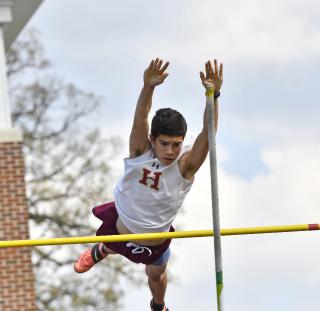
Not long after, Sixth Former Wells Flinn powered through the defense and bagged his first goal of the game.
Haverford players gained momentum and went on a 4-1 scoring run with goals from Ryan DiRocco, O’Kane, Fourth Former Evan Large, and Fifth Former Aydan DiRocco. This gave the Fords a 9-3 lead going into the final quarter.
Malvern players fought resiliently and weren’t ready to give up. They opened the fourth quarter with a goal from junior Ennis Udo, and an additional two goals by star midfielder A.J. Nikolic. Despite their strong efforts, their run crumbled as Ryan DiRocco delivered the final blow—another goal to top off his hat trick.
The Fords came out with a 10-6 victory over the Malvern Prep Friars.

Everyone on the field played their part well, but Haverford’s unpassable defensive play is what separated the two teams.
“Defense played great,” Sixth Former Brendan Leary said. “I thought Gavin Coo-
per and Louie Atkinson had a great game. Our face offs did a great job. We won the majority of them with Ben [McCarthy] and Griff [Meyer]. We had Brody [Murphy] in the net doing a great job, and the offense was clicking all over the place.”
“We take pride in our good defense,” Ryan DiRocco said. “They got us the win.”
Coach Brendan Dawson was thrilled to have gotten the win over such a competitive team.
“We played hard,” Coach Dawson
said. “It wasn’t exactly clean, but we battled through it by making plays. We played complementary to each other, offense and defense. I thought we cleared the ball pretty well, which was a big part of our plans going into it.”
Fred Jordan ’24 leads new-look pitching lineup
The pitching has been a strength so far—Jordan and Campbell combined for a no-hitter against Ridley High School on March 24—but the season has not come without its challenges.
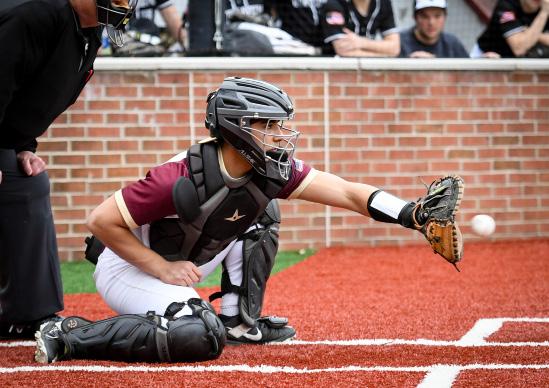

“We’re not getting hit around so much; it’s really the walks that are killing the vibe and the momentum,” Jordan said. “One inning we might go one, two, three, and then the next inning we walk the first guy, and that just shuts everything down. You really have to hone in and keep motivating yourself to throw the first pitch for a strike, so you can work ahead.”
Walks are one of the problems Jordan and the rest of the team will look to address as the pressure and intensity begin to increase.
“It’s still just about working on getting into the swing of things against live hitting,” Jordan said. “You prep all you can in the preseason, but nothing compares to going out on the mound with seven other guys behind
you, and trying not to disappoint them, not to mention the rest of the team.”
Jordan hopes to set an example for the younger players as his leadership role rises by always keeping his composure.
“[My leadership role] definitely has changed, but I’ve never really been one to be the speaking-type,” Jordan said. “Obviously we have guys in the huddle who talk all the time, and those are usually seniors and the other more talkative guys, but I’ve never really been like that. I’ll talk to guys on the side, but so far, leadership-wise, I’ve just been trying to motivate guys by setting examples. I’m not trying to lead by screaming at people; I’m trying to lead by going out there and pitching, working hard during practice, making plays, running and working out, and all those things.”
As the team aims for a strong second half of the season, Jordan wants to let his play do the talking as he proves himself every day.
Fords baseball has jumped out to a strong 12-3 start, and their lofty expectations from the start of the season remain intact. One major hurdle that the team has had to overcome is the turnaround on the pitching mound, including having to find a new pitching coach. They recently filled the vacancy by hiring Coach Anthony Cimabue, who had been at Wilmington University for over a decade.
One leader of the pitching lineup has been Fifth Former Fred Jordan, who feels that the players responded well to the circumstances over the past several months.
“[Coach Cimabue] came a little late into the season, so we didn’t really have any offseason time with him, and all the pitchers were on their own, more or less,” Jordan said. “You can go to personal guys, YouTube, [or]
go to Coach Rosko and do weightlifting.”
The team has adapted to the developing coaching situation, but there has also been a significant change in the roster itself. Three of the six Sixth Formers from last season were pitchers, and the departure of last year’s leader Colby McNeely has been especially impactful.
“We did lose a key role in Colby; he ate up around thirty-five innings last season, so this season’s just about finding new guys to step in and take up those thirty-five innings,” Jordan said. “[Sixth Former] Jac Campbell’s gotten some more innings, [Sixth Former] Ryan Davey’s getting some more innings, [Fifth Former] Noah Trexler’s gotten some innings. It’s just about finding those guys and finding a solid rotation both in-league and out-of-league that can lead to success.”
MR. JIM ROESE
Coach Dawson rallies the team before facing McDonough last March
Fred Jordan ’24 pitches in a 7-5 win against Strath Haven, March 17, 2023 COMMUNICATIONS Adiyan Nayak ’24
“Defense played
great... and the offense was clicking all over the place.”
the index · sports April 2023 Page 28
BRENDAN LEARY ’23
Mark Quatrani ’23 in the same game against Strath Haven
COMMUNICATIONS


























 The quiet stacks of Severinghaus Library
Mr. Keith Belson in early morning play on April 14
The quiet stacks of Severinghaus Library
Mr. Keith Belson in early morning play on April 14













 Luca Aloi ’25
Arsh Aggarwal ’24
Luca Aloi ’25
Arsh Aggarwal ’24













 Zach Shah ’23
Zach Shah ’23











 Charlie O’Brien ’23
Charlie O’Brien ’23










 Love, Death, and Robots premiered in 2019
Love, Death, and Robots premiered in 2019







